-
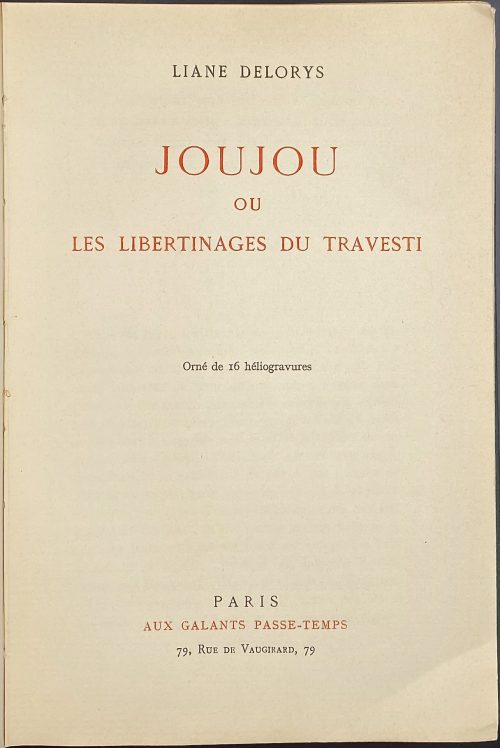 Description: Hardcover, 24.5 x 16.5 cm, collated 8vo, bound in quarter green marbled sheepskin over buckram boards, publisher’s wrappers preserved. Front wrapper and title-page (red and black): LIANE DELORYS | JOUJOU | OU | LES LIBERTINAGES DU TRAVESTI | Orné de 16 héliogravures | PARIS | AUX GALANTS PASSE-TEMPS | 79, Rue de Vaugirard, 79 || Collation: [1]8 (2 blanks, h.t./advert., t.p./limit., text), 2-178 on laid paper (total 136 leaves) plus 16 photomechanical b/w plates, incl. frontispiece on thick wove paper. Pagination: [1-9] 10-269 [3], total 272 pages, ils. Limitation: a print run of 2,050 copies on vergé antique Hollande reserved for subscribers, of which this is copy № 379. Contributors: Author: Liane Delorys – pen name; the real name is unknown; according to various sources other pseudonyms of this author are: Liane Lauré, Liane de Lorys, Liane de Lauris, Lucette de Chata, and G. Donville. The latter may be a real name, though there is no information even about the gender of this person. Publisher: Aux Galants Passe-temps, i.e. Jean Fort or Jean-Marie Fort (French, fl. c. 1907 – 1839), also published under the name of ‘Collection des Orties Blanches’, ‘Bon Vieux temps’, ‘Au Cabinet du Livre’. Artist: Chéri Hérouard (French, 1881 – 1961). Printer: Darantiere (Dijon), i.e. Maurice Darantiere (French, 1882 – 1962).
Description: Hardcover, 24.5 x 16.5 cm, collated 8vo, bound in quarter green marbled sheepskin over buckram boards, publisher’s wrappers preserved. Front wrapper and title-page (red and black): LIANE DELORYS | JOUJOU | OU | LES LIBERTINAGES DU TRAVESTI | Orné de 16 héliogravures | PARIS | AUX GALANTS PASSE-TEMPS | 79, Rue de Vaugirard, 79 || Collation: [1]8 (2 blanks, h.t./advert., t.p./limit., text), 2-178 on laid paper (total 136 leaves) plus 16 photomechanical b/w plates, incl. frontispiece on thick wove paper. Pagination: [1-9] 10-269 [3], total 272 pages, ils. Limitation: a print run of 2,050 copies on vergé antique Hollande reserved for subscribers, of which this is copy № 379. Contributors: Author: Liane Delorys – pen name; the real name is unknown; according to various sources other pseudonyms of this author are: Liane Lauré, Liane de Lorys, Liane de Lauris, Lucette de Chata, and G. Donville. The latter may be a real name, though there is no information even about the gender of this person. Publisher: Aux Galants Passe-temps, i.e. Jean Fort or Jean-Marie Fort (French, fl. c. 1907 – 1839), also published under the name of ‘Collection des Orties Blanches’, ‘Bon Vieux temps’, ‘Au Cabinet du Livre’. Artist: Chéri Hérouard (French, 1881 – 1961). Printer: Darantiere (Dijon), i.e. Maurice Darantiere (French, 1882 – 1962). -
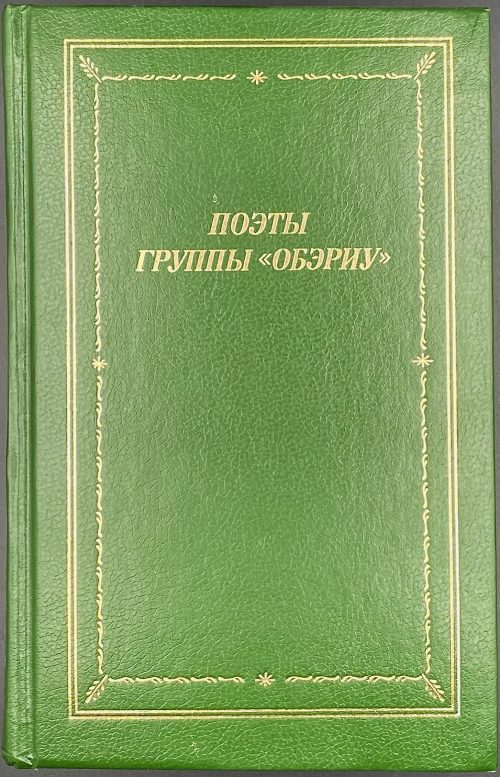 Collection of poems. Hardcover volume, 20.7 x 13.3 cm, bound in green buckram, gilt double-fillet border, gilt frame, gilt lettering to front, gilt stars, fillets and lettering to spine, blind lettering to back, matching endpapers, pp.: [1-4] 5-637 [638] [2], total 640 pages, collated in-16mo, [1]-1116, 8 leaves of plates, 13-2116. Title-page: ПОЭТЫ | ГРУППЫ «ОБЭРИУ» | С.-ПЕТЕРБУРГСКОЕ ОТДЕЛЕНИЕ • 1994 || Opposite to t.p.: БИБЛИОТЕКА ПОЭТА | ОСНОВАНА МАКСИМОМ ГОРЬКИМ В 1931 ГОДУ | БОЛЬШАЯ СЕРИЯ | ИЗДАНИЕ | ТРЕТЬЕ | СОВЕТСКИЙ ПИСАТЕЛЬ || Print run: 3,000 copies. Contributors: Михаил Борисович Мейлах (Russian-Jewish, b. 1944) Татьяна Львовна Никольская (Russian, b. 1945) Александр Николаевич Олейников (Russian, 1936 – 2013) Владимир Ибрагимович Эрль [Владимир Иванович Горбунов] (Russian, 1947 – 2020) ОБЭРИУ (Объединение Реального Искусства) Даниил Иванович Хармс [Ювачёв] (Russian, 1905 – 1942) Александр Иванович Введенский (Russian, 1904 – 1941) Николай Алексеевич Заболоцкий (Russian, 1903 – 1958) Игорь Владимирович Бахтерев (Russian, 1908 – 1996) Николай Макарович Олейников (Russian, 1898 – 1937) Константин Константинович Вагинов [Вагенгейм] (Russian, 1899 – 1934)
Collection of poems. Hardcover volume, 20.7 x 13.3 cm, bound in green buckram, gilt double-fillet border, gilt frame, gilt lettering to front, gilt stars, fillets and lettering to spine, blind lettering to back, matching endpapers, pp.: [1-4] 5-637 [638] [2], total 640 pages, collated in-16mo, [1]-1116, 8 leaves of plates, 13-2116. Title-page: ПОЭТЫ | ГРУППЫ «ОБЭРИУ» | С.-ПЕТЕРБУРГСКОЕ ОТДЕЛЕНИЕ • 1994 || Opposite to t.p.: БИБЛИОТЕКА ПОЭТА | ОСНОВАНА МАКСИМОМ ГОРЬКИМ В 1931 ГОДУ | БОЛЬШАЯ СЕРИЯ | ИЗДАНИЕ | ТРЕТЬЕ | СОВЕТСКИЙ ПИСАТЕЛЬ || Print run: 3,000 copies. Contributors: Михаил Борисович Мейлах (Russian-Jewish, b. 1944) Татьяна Львовна Никольская (Russian, b. 1945) Александр Николаевич Олейников (Russian, 1936 – 2013) Владимир Ибрагимович Эрль [Владимир Иванович Горбунов] (Russian, 1947 – 2020) ОБЭРИУ (Объединение Реального Искусства) Даниил Иванович Хармс [Ювачёв] (Russian, 1905 – 1942) Александр Иванович Введенский (Russian, 1904 – 1941) Николай Алексеевич Заболоцкий (Russian, 1903 – 1958) Игорь Владимирович Бахтерев (Russian, 1908 – 1996) Николай Макарович Олейников (Russian, 1898 – 1937) Константин Константинович Вагинов [Вагенгейм] (Russian, 1899 – 1934) -
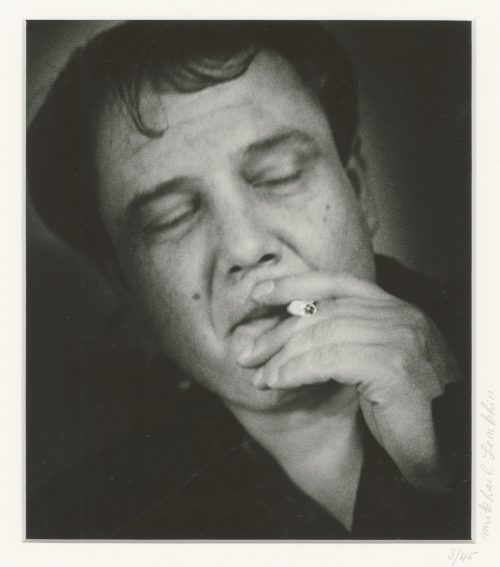 Photographic portrait of writer Vladimir Bukovsky with head tilted, closed eyes, and smoking a cigarette. Pencil-signed on the mat: 3/45 • Mikhail Lemkhin; on the back of the print: ink stamp ©MIKHAIL LEMKHIN, ink inscription ©mikhail Lemkhin; ink stamp: PHOTO BY: | MIKHAIL LEMKHIN | 2327 – 38th AVENUE | SAN FRANCISCO, CA 94116 | (415) 664-7677, pencil inscription 3/45 Mikhail Lemkhin; pencil inscription on the back of the mat: (top) ВЛАДИМИР БУКОВСКИЙ | VLADIMIR BUKOVSKY, (bottom) VI. Size: mat: 43.2 x 35.7 cm; window: 21.5 x 18.5 cm; print: 25.3 x 20.3 cm. Limited edition of 45, of which this is № 3, signed and stamped by the artist. Sitter: Vladimir Bukovsky [Владимир Константинович Буковский] (Russian, 1942 – 2019). Popularity: Bukovsky left the Soviet Union, where he was kept in prison for his political views, in exchange for Luis Alberto Corvalán, a Chilean communist. The event was commemorated in the following folk verse:
Photographic portrait of writer Vladimir Bukovsky with head tilted, closed eyes, and smoking a cigarette. Pencil-signed on the mat: 3/45 • Mikhail Lemkhin; on the back of the print: ink stamp ©MIKHAIL LEMKHIN, ink inscription ©mikhail Lemkhin; ink stamp: PHOTO BY: | MIKHAIL LEMKHIN | 2327 – 38th AVENUE | SAN FRANCISCO, CA 94116 | (415) 664-7677, pencil inscription 3/45 Mikhail Lemkhin; pencil inscription on the back of the mat: (top) ВЛАДИМИР БУКОВСКИЙ | VLADIMIR BUKOVSKY, (bottom) VI. Size: mat: 43.2 x 35.7 cm; window: 21.5 x 18.5 cm; print: 25.3 x 20.3 cm. Limited edition of 45, of which this is № 3, signed and stamped by the artist. Sitter: Vladimir Bukovsky [Владимир Константинович Буковский] (Russian, 1942 – 2019). Popularity: Bukovsky left the Soviet Union, where he was kept in prison for his political views, in exchange for Luis Alberto Corvalán, a Chilean communist. The event was commemorated in the following folk verse:Обменяли хулигана На Луиса Корвалана. Где б найти такую блядь, Чтоб на Брежнева сменять!
This can be translated as a Haiku:A troublemaker was exchanged for Luis Corvalán... Where to find a whore to exchange for Brezhnev?
-
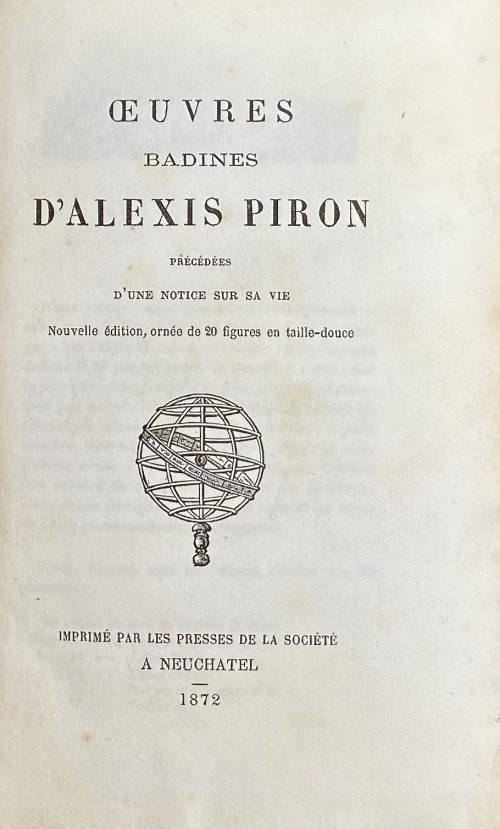 Single volume, 17.1 x 11.2 cm, quarter black sheepskin over faux chagrin, gilt lettering to spine, marbled endpapers, bottom and outer margin untrimmed, pp.: [i-v] vi- xxxvi, [1] 2-218 [2], collated 4to: π2, a-d4, 1-274 282, total 256 pages or 128 leaves, plus 20 engraved plates by Paul Sellier, including frontispiece portrait of Alexis Piron after bust by Caffieri. Vol. 8 of Bibliothèque Libre, Œuvres badines de Piron, printed on February 15, 1872. Text printed on dense wove paper watermarked P or M, plates printed on India wove paper. A reprint of an edition published in 1796 plus illustrations. Title-page: ŒUVRES | BADINES | D’ALEXIS PIRON | PRÉCÉDÉES | D’UNE NOTICE SUR SA VIE | Nouvelle édition, ornée de 20 figures en taille-douce | {vignette} | IMPRIMÉ PAR LES PRESSES DE LA SOCIÉTÉ | A NEUCHATEL | – | 1872 || Limitation: 100 numbered copies, of which this is № 75. Catalogue raisonné: Dutel I: A-788; Pia: 953-6; Kearney 377 (Patrick J. Kearney. A Catalogue of the publications of Jules Gay, Jean-Jules Gay & Gay et Doucé, revised & expanded. — Santa Rosa, CA Scissors & Paste Bibliographies, 2019) Catalogue Poulet-Malassis & ses amis description: № 81. Alexis PIRON. Œuvres badines précédées d’une notice sur sa vie. Nouvelle édition ornée de 20 figures en taille-douce. [ Jules Gay] Imprimé par les presses de la société, à Neufchatel, 1872. In-8, xxxvi, 218 pages et un feuillet d’achevé d’imprimer de table, demi-basane noire, dos à faux nerfs, tête et tranches naturelles. Illustré d’un portrait et de 20 figures par Paul Sellier. Tirage limité à 100 ex. numérotés. De la « Bibliothèque libre ou collection choisie d’ouvrages du genre libre, imprimés ou réimprimés par les soins de la Société des Bibliophiles Cosmopolites et pour les membres de cette société, à cent exemplaires numérotés ». Bibliographie : Pia 1030, Enfer 1274, Lem 3-454, Gay 5-339, PC 353, G* 38, Pey 203, Dutel A-788." Contributors: Alexis Piron (French, 1689 – 1773) – author. Paul Sellier (French, 1842 – 19..?) – artist. Jules Léopold Gay (French, 1807 – 1887) – publisher.
Single volume, 17.1 x 11.2 cm, quarter black sheepskin over faux chagrin, gilt lettering to spine, marbled endpapers, bottom and outer margin untrimmed, pp.: [i-v] vi- xxxvi, [1] 2-218 [2], collated 4to: π2, a-d4, 1-274 282, total 256 pages or 128 leaves, plus 20 engraved plates by Paul Sellier, including frontispiece portrait of Alexis Piron after bust by Caffieri. Vol. 8 of Bibliothèque Libre, Œuvres badines de Piron, printed on February 15, 1872. Text printed on dense wove paper watermarked P or M, plates printed on India wove paper. A reprint of an edition published in 1796 plus illustrations. Title-page: ŒUVRES | BADINES | D’ALEXIS PIRON | PRÉCÉDÉES | D’UNE NOTICE SUR SA VIE | Nouvelle édition, ornée de 20 figures en taille-douce | {vignette} | IMPRIMÉ PAR LES PRESSES DE LA SOCIÉTÉ | A NEUCHATEL | – | 1872 || Limitation: 100 numbered copies, of which this is № 75. Catalogue raisonné: Dutel I: A-788; Pia: 953-6; Kearney 377 (Patrick J. Kearney. A Catalogue of the publications of Jules Gay, Jean-Jules Gay & Gay et Doucé, revised & expanded. — Santa Rosa, CA Scissors & Paste Bibliographies, 2019) Catalogue Poulet-Malassis & ses amis description: № 81. Alexis PIRON. Œuvres badines précédées d’une notice sur sa vie. Nouvelle édition ornée de 20 figures en taille-douce. [ Jules Gay] Imprimé par les presses de la société, à Neufchatel, 1872. In-8, xxxvi, 218 pages et un feuillet d’achevé d’imprimer de table, demi-basane noire, dos à faux nerfs, tête et tranches naturelles. Illustré d’un portrait et de 20 figures par Paul Sellier. Tirage limité à 100 ex. numérotés. De la « Bibliothèque libre ou collection choisie d’ouvrages du genre libre, imprimés ou réimprimés par les soins de la Société des Bibliophiles Cosmopolites et pour les membres de cette société, à cent exemplaires numérotés ». Bibliographie : Pia 1030, Enfer 1274, Lem 3-454, Gay 5-339, PC 353, G* 38, Pey 203, Dutel A-788." Contributors: Alexis Piron (French, 1689 – 1773) – author. Paul Sellier (French, 1842 – 19..?) – artist. Jules Léopold Gay (French, 1807 – 1887) – publisher. -
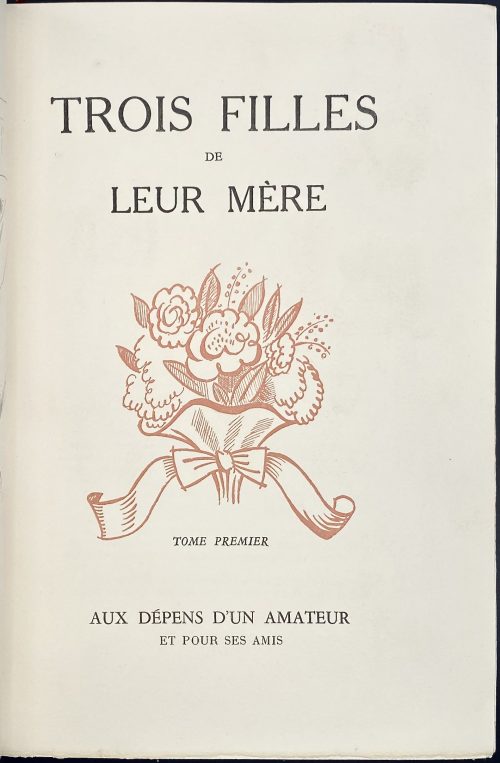 Two softcover volumes bound in one, 28.7 x 20.5 cm, quarter blue morocco over marbled boards, raised bands and gilt lettering to spine, top margin gilt, other untrimmed, marbled endpapers, original covers and spines preserved; 20 full-page etchings by Louis Berthommé Saint-André, incl. 2 frontispieces; vignettes, initials, head- and tailpieces in pink after André Collot. Title-page: TROIS FILLES | DE | LEUR MÈRE | {vignette} | TOME PREMIER (SECOND) | AUX DÉPENS D'UN AMATEUR | ET POUR SES AMIS || Collation: v.1 2ffl, front cover, [1-8] 2 blanks, h.t., t.p., pp. 9-94 [95, 96]; v.2 back cover, spine, front cover, 2 blanks, h.t., t.p., 97-201 [202-4] back cover, spine, 2ffl; plus 20 plates extraneous to collation. Limitation: A print run of 150 copies, of which this is copy № 76. Catalogue raisonné: Dutel III № 2521. As per Dutel, pp: 96+106 (conforms), and the year of 2 vol. publication 1933; however, the etchings are dated to 1926 by many. Contributors: Pierre Louÿs (French, 1870 – 1925) – author. Louis Berthommé Saint-André (French, 1905 – 1977) – artist. André Collot (French, 1897 – 1976) – artist.
Two softcover volumes bound in one, 28.7 x 20.5 cm, quarter blue morocco over marbled boards, raised bands and gilt lettering to spine, top margin gilt, other untrimmed, marbled endpapers, original covers and spines preserved; 20 full-page etchings by Louis Berthommé Saint-André, incl. 2 frontispieces; vignettes, initials, head- and tailpieces in pink after André Collot. Title-page: TROIS FILLES | DE | LEUR MÈRE | {vignette} | TOME PREMIER (SECOND) | AUX DÉPENS D'UN AMATEUR | ET POUR SES AMIS || Collation: v.1 2ffl, front cover, [1-8] 2 blanks, h.t., t.p., pp. 9-94 [95, 96]; v.2 back cover, spine, front cover, 2 blanks, h.t., t.p., 97-201 [202-4] back cover, spine, 2ffl; plus 20 plates extraneous to collation. Limitation: A print run of 150 copies, of which this is copy № 76. Catalogue raisonné: Dutel III № 2521. As per Dutel, pp: 96+106 (conforms), and the year of 2 vol. publication 1933; however, the etchings are dated to 1926 by many. Contributors: Pierre Louÿs (French, 1870 – 1925) – author. Louis Berthommé Saint-André (French, 1905 – 1977) – artist. André Collot (French, 1897 – 1976) – artist. -
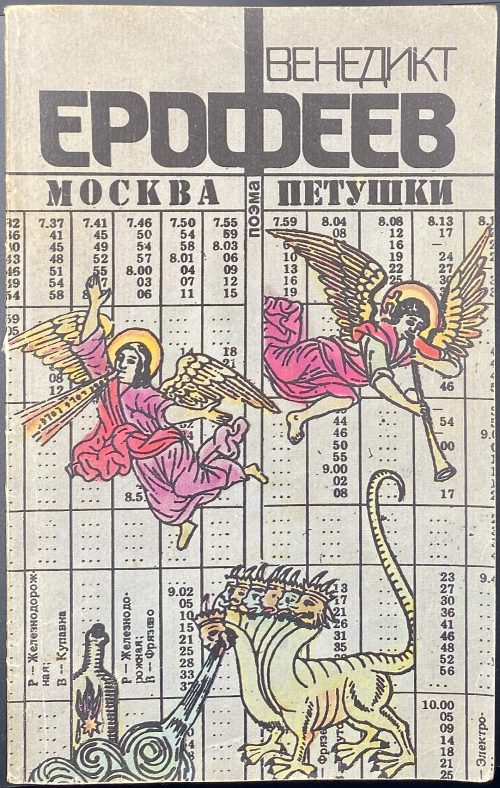 Paperback, 20 x 12.5 cm, grey pictorial wrappers, lettering to front, back, and spine; pp.: [1-2] 3-127 [128]. Title-page: ВЕНЕДИКТ | EРОФЕЕВ | in grid: МОСКВА Р/6520 6308 6494 | {text in grid} | ПЕТУШКИ {publisher’s device} МОСКВА / «ИНТЕРБУК» / 1990 || Print-run: 250,000. Contributors: Венедикт Васильевич Ерофеев [Venedikt Yerofeyev] (Russian, 1938 – 1990) – author.
Paperback, 20 x 12.5 cm, grey pictorial wrappers, lettering to front, back, and spine; pp.: [1-2] 3-127 [128]. Title-page: ВЕНЕДИКТ | EРОФЕЕВ | in grid: МОСКВА Р/6520 6308 6494 | {text in grid} | ПЕТУШКИ {publisher’s device} МОСКВА / «ИНТЕРБУК» / 1990 || Print-run: 250,000. Contributors: Венедикт Васильевич Ерофеев [Venedikt Yerofeyev] (Russian, 1938 – 1990) – author. -
 Artist: Utagawa Kunisada [歌川 国貞], a.k.a. Utagawa Toyokuni III [三代 歌川 豊国] (Japanese, 1786 – 1865). Signed: Toyokuni ga [豊国 画] in a red toshidama cartouche Block carver: Yokokawa Takejirō [横川竹二郎] (Japanese, fl. 1845 – 1863), seal: 彫竹 – hori Take. Publisher: Ibaya Senzaburō [伊場屋仙三郎] (Japanese, fl. c. 1845 – 1847). Media: Untrimmed fan print (uchiwa-e), 238 x 304 mm. Title: Saiko (West River) [西江]; 西江 means the Xi River in China. Series: Chronicles of Elegant Women [風雅女史傳] (Fūga joshiden). Combined date seal and kiwame censor seal: Ansei 6 (1859). Other prints from the same series in this collection: SVJP-0216.2016 — Princess Sotoori:
Artist: Utagawa Kunisada [歌川 国貞], a.k.a. Utagawa Toyokuni III [三代 歌川 豊国] (Japanese, 1786 – 1865). Signed: Toyokuni ga [豊国 画] in a red toshidama cartouche Block carver: Yokokawa Takejirō [横川竹二郎] (Japanese, fl. 1845 – 1863), seal: 彫竹 – hori Take. Publisher: Ibaya Senzaburō [伊場屋仙三郎] (Japanese, fl. c. 1845 – 1847). Media: Untrimmed fan print (uchiwa-e), 238 x 304 mm. Title: Saiko (West River) [西江]; 西江 means the Xi River in China. Series: Chronicles of Elegant Women [風雅女史傳] (Fūga joshiden). Combined date seal and kiwame censor seal: Ansei 6 (1859). Other prints from the same series in this collection: SVJP-0216.2016 — Princess Sotoori:

-
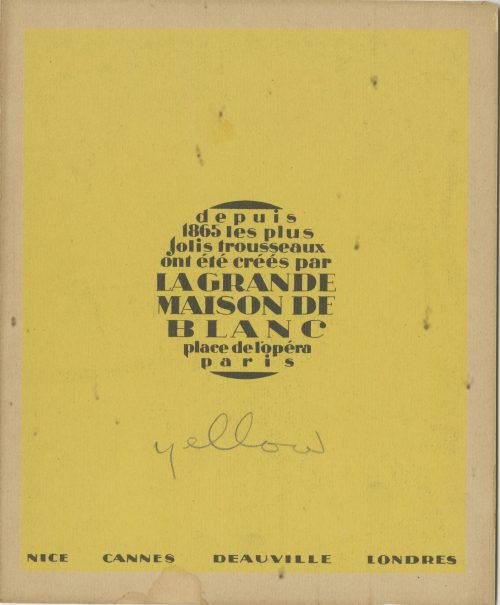 Four chromolithographic plates, each sheet 180 x 150 mm; image 16 x 12.5 cm after Feodor Rojankovsky, signed “Rojan”, titles printed on the back on red (à la chasse), blue (en voyage), green (aux courses), and yellow (depuis | 1865 les plus | jolis trousseaux | ont été créés par | LA GRANDE | MAISON DE | BLANC | place de l’opera | Paris | NICE CANNES DEAUVILLE LONDRES) background. Contributors: Feodor Rojankovsky [Rojan, Фёдор Степанович Рожанковский] (Russian-American, 1891 – 1970) – artist.
Four chromolithographic plates, each sheet 180 x 150 mm; image 16 x 12.5 cm after Feodor Rojankovsky, signed “Rojan”, titles printed on the back on red (à la chasse), blue (en voyage), green (aux courses), and yellow (depuis | 1865 les plus | jolis trousseaux | ont été créés par | LA GRANDE | MAISON DE | BLANC | place de l’opera | Paris | NICE CANNES DEAUVILLE LONDRES) background. Contributors: Feodor Rojankovsky [Rojan, Фёдор Степанович Рожанковский] (Russian-American, 1891 – 1970) – artist. -
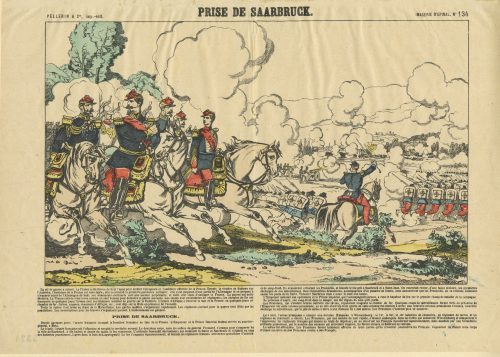 Hand-coloured woodcut on wove paper, 268 x 381 mm, vertical centerfold. On reverse: black ink stamp “5324”. Top centre: "PRISE DE SAARBRUCK"; left: "PELLERIN & Cie, imp. -édit."; right: "IMAGERIE D'EPINAL, № 134." Under the frame text starts with « La cri de guerre a retenti. La France a été forcée de tirer l’épée pour arrêter… ».[...] Prise de Saarbruck. | Depuis quelques jours, l’armée française occupait la frontière française en face de la Prusse.... Jean Charles Pellerin (French, 1756 – 1836) – publisher/printer. The Battle of Saarbrücken (2 August 1870).
Hand-coloured woodcut on wove paper, 268 x 381 mm, vertical centerfold. On reverse: black ink stamp “5324”. Top centre: "PRISE DE SAARBRUCK"; left: "PELLERIN & Cie, imp. -édit."; right: "IMAGERIE D'EPINAL, № 134." Under the frame text starts with « La cri de guerre a retenti. La France a été forcée de tirer l’épée pour arrêter… ».[...] Prise de Saarbruck. | Depuis quelques jours, l’armée française occupait la frontière française en face de la Prusse.... Jean Charles Pellerin (French, 1756 – 1836) – publisher/printer. The Battle of Saarbrücken (2 August 1870). -
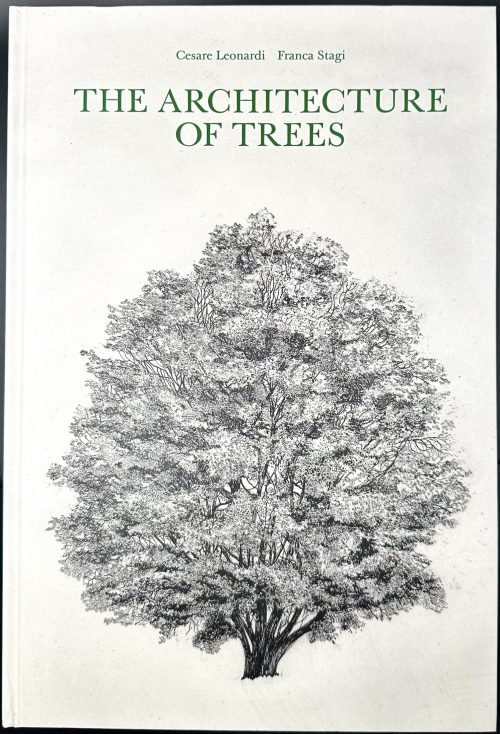 Hardcover volume, 38.3 x 26 x 3.8 cm, pictorial boards, lettering to front cover and spine, pp.: [1-6] 7-421 [3], ils. Title-page: Cesare Leonardi Franca Stagi | THE ARCHITECTURE | OF TREES | Introduction to the new edition | ANDREA CAVANI, GIULIO ORSINI | Translated from the Italian by | NATALIE DANFORD | Princeton Architectural Press | New York || Cesare Leonardi (Italian, 1935 – 2021) Franca Stagi (Italian, 1937 – 2008) Natalie Danford (American, b. 1968)
Hardcover volume, 38.3 x 26 x 3.8 cm, pictorial boards, lettering to front cover and spine, pp.: [1-6] 7-421 [3], ils. Title-page: Cesare Leonardi Franca Stagi | THE ARCHITECTURE | OF TREES | Introduction to the new edition | ANDREA CAVANI, GIULIO ORSINI | Translated from the Italian by | NATALIE DANFORD | Princeton Architectural Press | New York || Cesare Leonardi (Italian, 1935 – 2021) Franca Stagi (Italian, 1937 – 2008) Natalie Danford (American, b. 1968) -
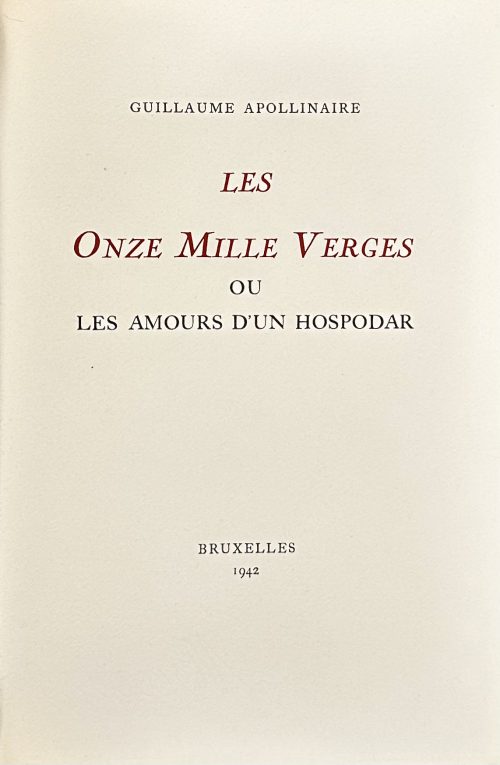 Softcover, 257 x 168 mm, publisher’s cream French flapped wrappers with red lettering to front in a beige double slipcase, printed on wove paper watermarked “Marais” in italic script; edges untrimmed; pp.: [8] [2] [1] 2-130 [131] [3]; collated 4to as 184, 72 leaves incl. those in the wrappers, plus 9 photomechanical stencil-coloured plates extraneous to collation and 9 b/w headpieces (in-text etchings) after anonymous artist. According to the seller and J.-P. Dutel: “In-8 of 130 pages... Illustrated with 10 full-page in colour and some headbands. Limited edition of 500 copies on vélin du Marais". Title-page (red and black): GUILLAUME APOLLINAIRE | LES | ONZE MILLE VERGES | OU | LES AMOURS D'UN HOSPODAR | BRUXELLES | 1942 || Limitation: Il a été tiré de cet ouvrage réservé uniquement aux souscripteurs particuliers 500 exemplaires tous sur vélin du marais. Exemplaire n° 147. Edition: The clandestine edition on vélin de Marais paper limited to 500 copies for subscribers only; this copy is № 147. Catalogue raisonné: Dutel III № 2109. In my copy, similarly to the one of STEVE M., it is only 9 colour plates, while Dutel sites 10. Author: Guillaume Apollinaire (French, 1880 – 1918). Micro photo of a colour plate:
Softcover, 257 x 168 mm, publisher’s cream French flapped wrappers with red lettering to front in a beige double slipcase, printed on wove paper watermarked “Marais” in italic script; edges untrimmed; pp.: [8] [2] [1] 2-130 [131] [3]; collated 4to as 184, 72 leaves incl. those in the wrappers, plus 9 photomechanical stencil-coloured plates extraneous to collation and 9 b/w headpieces (in-text etchings) after anonymous artist. According to the seller and J.-P. Dutel: “In-8 of 130 pages... Illustrated with 10 full-page in colour and some headbands. Limited edition of 500 copies on vélin du Marais". Title-page (red and black): GUILLAUME APOLLINAIRE | LES | ONZE MILLE VERGES | OU | LES AMOURS D'UN HOSPODAR | BRUXELLES | 1942 || Limitation: Il a été tiré de cet ouvrage réservé uniquement aux souscripteurs particuliers 500 exemplaires tous sur vélin du marais. Exemplaire n° 147. Edition: The clandestine edition on vélin de Marais paper limited to 500 copies for subscribers only; this copy is № 147. Catalogue raisonné: Dutel III № 2109. In my copy, similarly to the one of STEVE M., it is only 9 colour plates, while Dutel sites 10. Author: Guillaume Apollinaire (French, 1880 – 1918). Micro photo of a colour plate: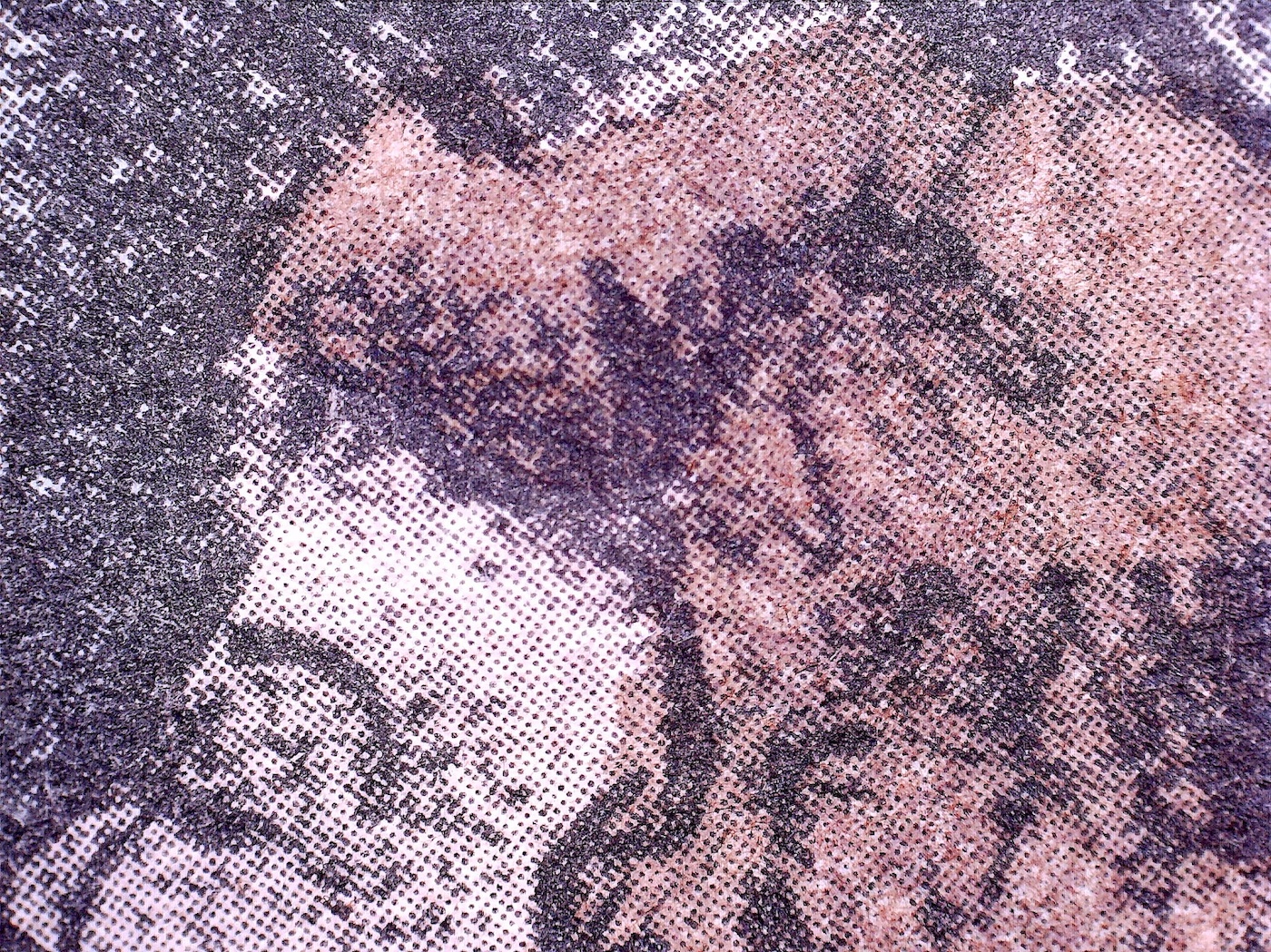 Micro photo of an etching:
Micro photo of an etching:
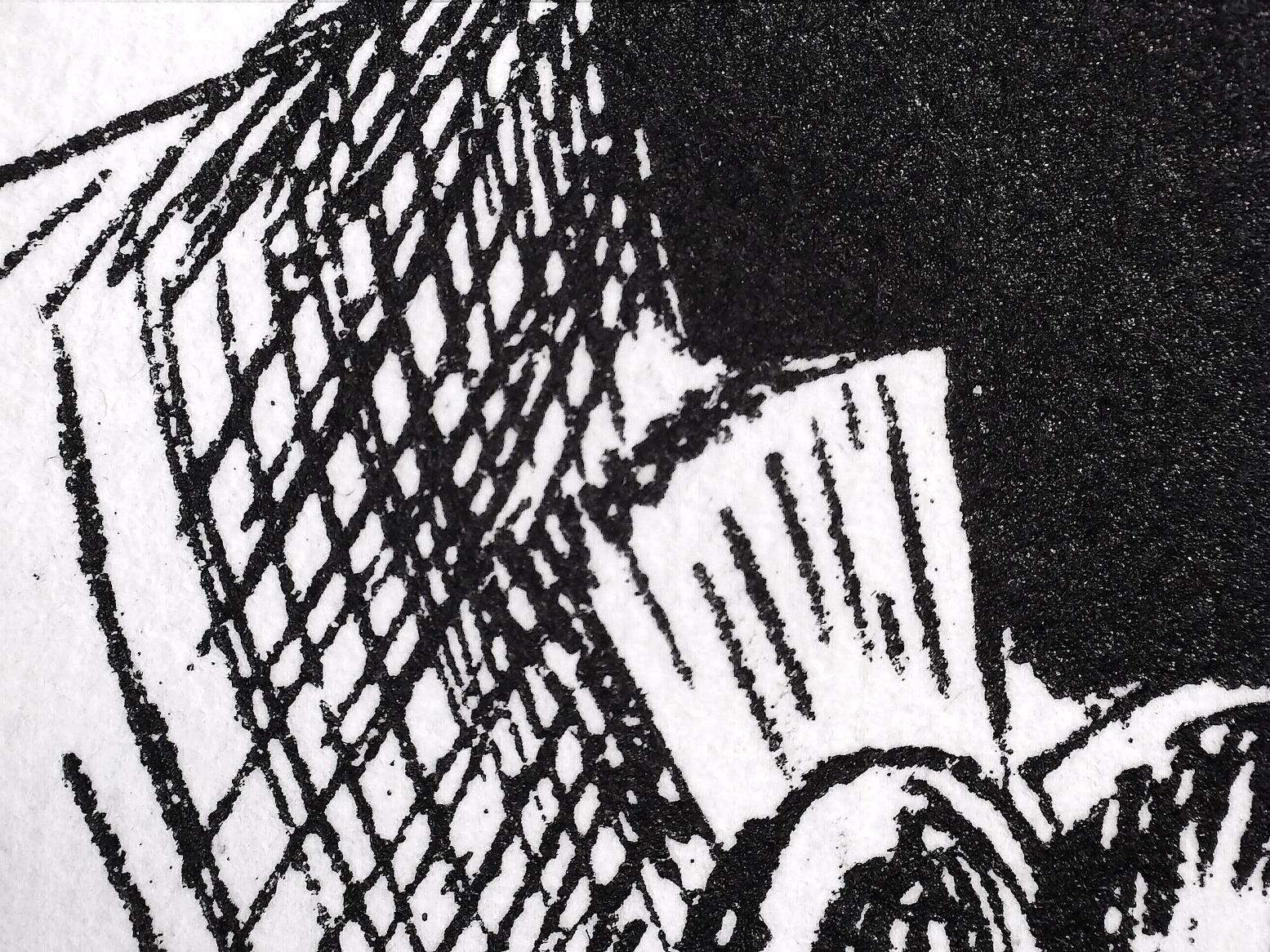
-
 Iron tsuba of quatrefoil form with design of bamboo stems and leaves, and a plank bridge in openwork (sukashi). Hitsu-ana of irregular form. Iron with smooth chocolate patina. Copper and shakudō sekigane. This piece is illustrated in Sasano: Japanese Sword Guard Masterpieces from the Sasano Collection, 1994 on page 295 under № 254 with the following description:
Iron tsuba of quatrefoil form with design of bamboo stems and leaves, and a plank bridge in openwork (sukashi). Hitsu-ana of irregular form. Iron with smooth chocolate patina. Copper and shakudō sekigane. This piece is illustrated in Sasano: Japanese Sword Guard Masterpieces from the Sasano Collection, 1994 on page 295 under № 254 with the following description:Nishigaki. First generation Kanshiro (died in the sixth year of Genroku, 1693, at the age of 81). Sukashi design: Bamboo (take). Early Edo period, late 17th century (Kanbun / Enppo era). Height: 72.6 mm; Width: 71.5 mm; Rim thickness: .6 mm; Centre thickness: 5.1 mm. Rounded rim. The shape of this sword guard is a quatrefoil and the design is arranged in the form of a saddle flap. Two bamboo trunks with leaves comprise the design. Calm, soothing and sophisticated are the features of this artist in his later years. Such characteristics may remind one of the work of the first Hikozo.
Provenance: Sasano Masayuki collection, № 254. What is interesting, and what had been found by Bruce Kirkpatrick, is that in the earlier photograph of the same piece ['Sukashi tsuba - bushido no bi' by Sasano Masayuki, photography by Fujimoto Shihara, 1972 (in Japanese), page 245, №201] we clearly see kebori - linear carving that decorates the bamboo leaves and the planks of the bridge. The said kebori have totally disappeared between 1972 and 1994. The tsuba became absolutely flat! Now we can only speculate about the reasons for such cruel treatment of the artistically and historically important item.
Sukashi tsuba - bushido no bi. Author: Sasano Masayuki, photography: Fujimoto Shihara, 1972 (in Japanese). Page 245, №201.
-
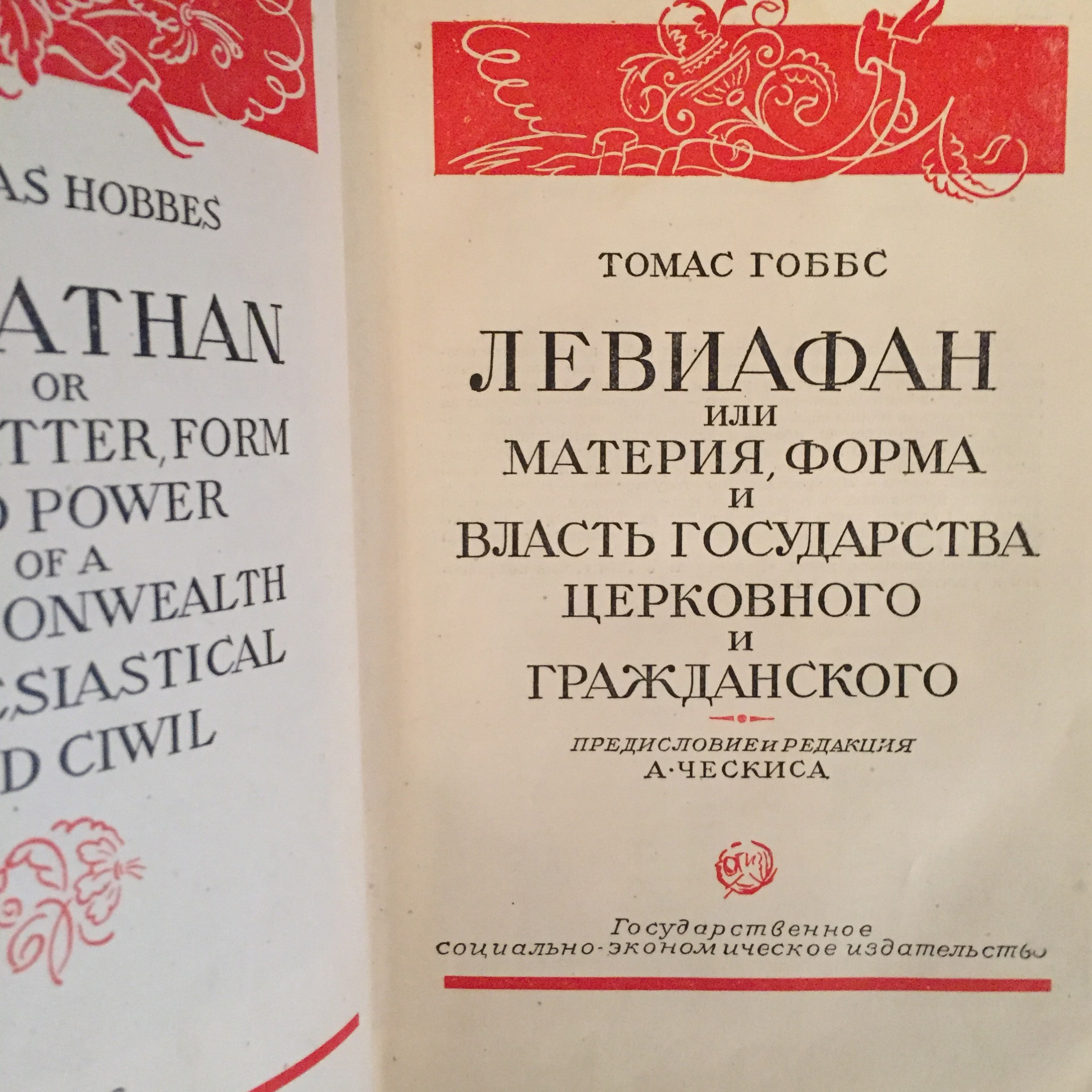
Гоббс Томас. Левиафан или материя, форма и власть государства церковного и гражданского. Предисловие и редакция А. Ческиса. - М.-Л.: Гос.соц.-эконом.из-во (СОЦЭКГИЗ), 1936. - 504 стр.
Тираж 10 000 экз.
Библиотека материализма. Томас Гоббс (1588-1679)ю
-
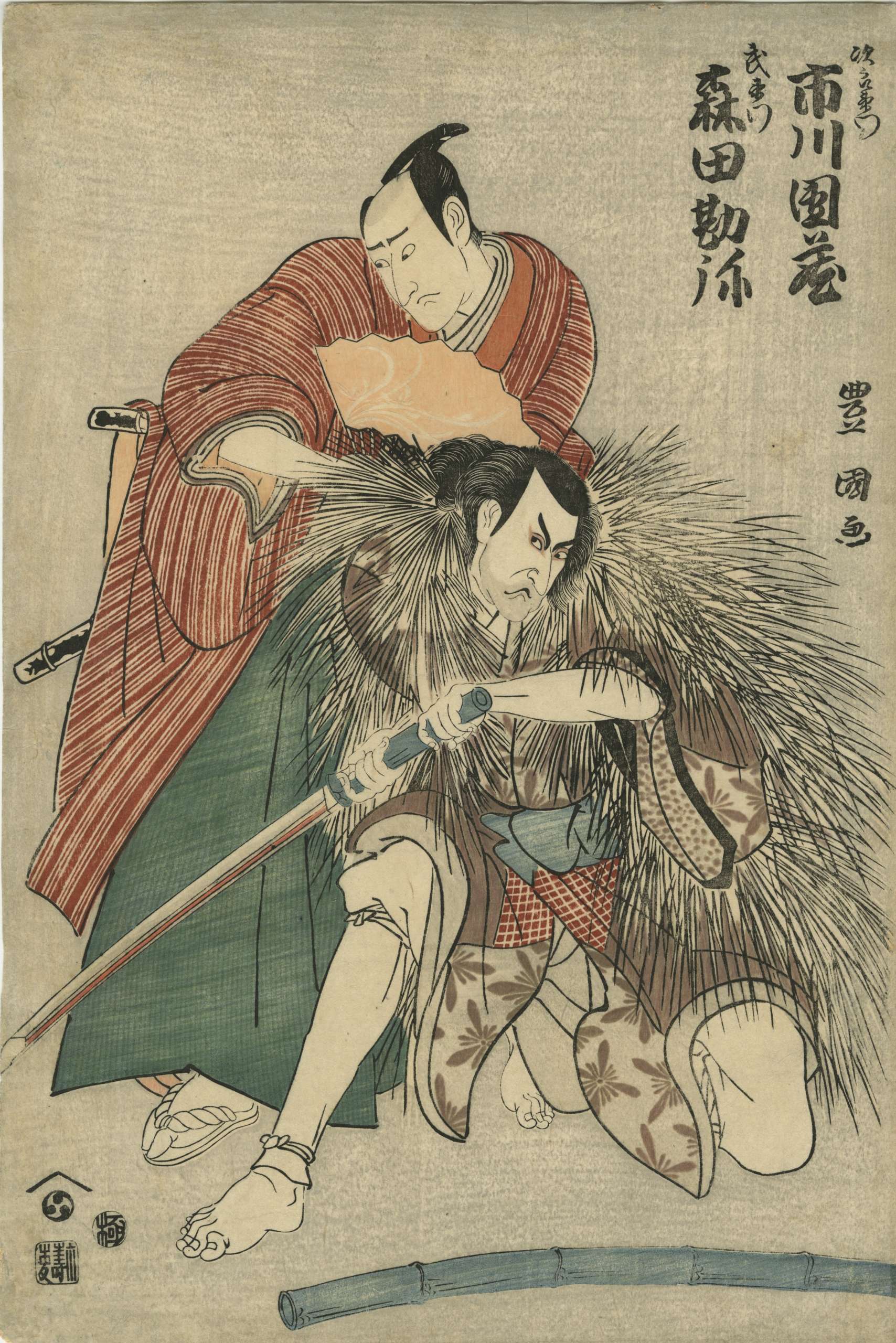 Utagawa Toyokuni (歌川豐國); 1769 – 24 February 1825. The kabuki actors Ichikawa Danzo IV as Jiroemon (in draw cape) and Morita Kanya VIII as Buemon. Play 'Oriai Tsuzure no Nishiki', performed at the Moritaza Theater in the 7th month of 1798. Publisher: Eijudo.
Utagawa Toyokuni (歌川豐國); 1769 – 24 February 1825. The kabuki actors Ichikawa Danzo IV as Jiroemon (in draw cape) and Morita Kanya VIII as Buemon. Play 'Oriai Tsuzure no Nishiki', performed at the Moritaza Theater in the 7th month of 1798. Publisher: Eijudo. -
 Iron tsuba of round form decorated with two boar's eyes (inome) and two dragonflies (tombo) in small openwork (ko-sukashi) outlined with brass wire. The plate also decorated with 2 to 5 concentric circular rows of brass dots (nail heads) in ten-zōgan. Center of the plate outlined with the inlaid circular brass wire. The inlaid metal is of red-ish hue, so it may be copper, and not brass. The surface has remnants of lacquer. Ōnin school. Mid Muromachi period, middle of 15th century. Dimensions: Diameter: 90 mm, thickness: 3.2 mm. Notes regarding design: "According to various sources, the dragonfly (tombo) is emblematic of martial success, as various names for the insect are homophones for words meaning "victory". The dragonfly is also auspicious because references in the Kojiki and Nihongi link it in both name and shape to the old kingdom of Yamato." [Merrily Baird. Symbols of Japan. Thematic motifs in art and design. Rizzoli international publications, Inc., 2001, p. 108]. "The dragonfly (tonbo), was also called kachimushi in earlier times, and due to the auspicious literal meaning "victory bug" of the characters of this word it became a popular theme on sword fittings." [Iron tsuba. The works of the exhibition "Kurogane no hana", The Japanese Sword Museum, 2014, p. 13]. Two other cutouts - in the form of what in European tradition symbolizes the heart, on the top and in the bottom of tsuba disc - may have two different explanations. The most usual one, inome - "Heart-shaped pattern, which is said to go back to the shape of a wild boar's eye" [Markus Sesko. Encyclopedia of Japanese Swords. Print and publishing: Lulu Enterprises, Inc., 2014.]. This understanding is shared by Robert Haynes [Robert E. Haynes. Study Collection of Japanese Sword Fittings. Nihon Art Publishers, 2010.] and elsewhere, with an exception of Okabe-Kakuya [Okabe-Kakuya. JAPANESE SWORD GUARDS. Museum of Fine Arts, Boston. In cooperation with the department of Chinese and Japanese art; - 1908, p. 14], who provides the illustration of inome-shaped cut-outs with the following explanation: " The tsuba shown in Fig. 13 approaches a square form with rounded corners and is perforated with Aoi decoration. But this book was written long time ago, when people even at MFA might not know enough...
Iron tsuba of round form decorated with two boar's eyes (inome) and two dragonflies (tombo) in small openwork (ko-sukashi) outlined with brass wire. The plate also decorated with 2 to 5 concentric circular rows of brass dots (nail heads) in ten-zōgan. Center of the plate outlined with the inlaid circular brass wire. The inlaid metal is of red-ish hue, so it may be copper, and not brass. The surface has remnants of lacquer. Ōnin school. Mid Muromachi period, middle of 15th century. Dimensions: Diameter: 90 mm, thickness: 3.2 mm. Notes regarding design: "According to various sources, the dragonfly (tombo) is emblematic of martial success, as various names for the insect are homophones for words meaning "victory". The dragonfly is also auspicious because references in the Kojiki and Nihongi link it in both name and shape to the old kingdom of Yamato." [Merrily Baird. Symbols of Japan. Thematic motifs in art and design. Rizzoli international publications, Inc., 2001, p. 108]. "The dragonfly (tonbo), was also called kachimushi in earlier times, and due to the auspicious literal meaning "victory bug" of the characters of this word it became a popular theme on sword fittings." [Iron tsuba. The works of the exhibition "Kurogane no hana", The Japanese Sword Museum, 2014, p. 13]. Two other cutouts - in the form of what in European tradition symbolizes the heart, on the top and in the bottom of tsuba disc - may have two different explanations. The most usual one, inome - "Heart-shaped pattern, which is said to go back to the shape of a wild boar's eye" [Markus Sesko. Encyclopedia of Japanese Swords. Print and publishing: Lulu Enterprises, Inc., 2014.]. This understanding is shared by Robert Haynes [Robert E. Haynes. Study Collection of Japanese Sword Fittings. Nihon Art Publishers, 2010.] and elsewhere, with an exception of Okabe-Kakuya [Okabe-Kakuya. JAPANESE SWORD GUARDS. Museum of Fine Arts, Boston. In cooperation with the department of Chinese and Japanese art; - 1908, p. 14], who provides the illustration of inome-shaped cut-outs with the following explanation: " The tsuba shown in Fig. 13 approaches a square form with rounded corners and is perforated with Aoi decoration. But this book was written long time ago, when people even at MFA might not know enough... The same interpretation of the said heart-like symbol (aoi leaf) is given at Helen C. Gunsaulus. Japanese sword-mounts in the collection of Field Museum. // Publication 216, Anthropological Series, Volume XVI; Chicago, 1923; p. 54: "This mokkō-formed tsuba recalls the aoi form, perforated as it is with the four aoi leaves." It is possible that the "wild boar's eye" theory was developed by later scholars.
The same interpretation of the said heart-like symbol (aoi leaf) is given at Helen C. Gunsaulus. Japanese sword-mounts in the collection of Field Museum. // Publication 216, Anthropological Series, Volume XVI; Chicago, 1923; p. 54: "This mokkō-formed tsuba recalls the aoi form, perforated as it is with the four aoi leaves." It is possible that the "wild boar's eye" theory was developed by later scholars.
 There is also a theory, supported by Graham Gemmell, saying that: “In simple terms Onin works are decorated Ko-Katchushi tsuba. … But, not content with iron alone, they began to decorate it with what was, in the early Muromachi period, a rare and valuable metal, brass. The Onin workers cut the design into the iron, using narrow channels, cast the brass, piece by piece, and then hammered it into the iron plate as though they were putting together a jigsaw. When complete the tsuba would be black lacquered exactly as the plain iron ones had been, the brass shining dully through it in a way that fulfilled the goal of shibui or restrained elegance.” [Tosogu. Treasure of the samurai. Fine Japanese Sword Fittings from The Muromachi to The Meiji Period, by Graham Gemmell. // Sarzi-Amadè Limited, London, 1991. An exhibition held in London from 21st March to 4th April, 1991]. The following illustration from Helen C. Gunsaulus. Japanese sword-mounts in the collection of Field Museum. // Publication 216, Anthropological Series, Volume XVI; Chicago, 1923; pp. 43 supports the idea.
There is also a theory, supported by Graham Gemmell, saying that: “In simple terms Onin works are decorated Ko-Katchushi tsuba. … But, not content with iron alone, they began to decorate it with what was, in the early Muromachi period, a rare and valuable metal, brass. The Onin workers cut the design into the iron, using narrow channels, cast the brass, piece by piece, and then hammered it into the iron plate as though they were putting together a jigsaw. When complete the tsuba would be black lacquered exactly as the plain iron ones had been, the brass shining dully through it in a way that fulfilled the goal of shibui or restrained elegance.” [Tosogu. Treasure of the samurai. Fine Japanese Sword Fittings from The Muromachi to The Meiji Period, by Graham Gemmell. // Sarzi-Amadè Limited, London, 1991. An exhibition held in London from 21st March to 4th April, 1991]. The following illustration from Helen C. Gunsaulus. Japanese sword-mounts in the collection of Field Museum. // Publication 216, Anthropological Series, Volume XVI; Chicago, 1923; pp. 43 supports the idea.
 Helen C. Gunsaulus' description of the dragonfly emblem is as follows: "This motive, the dragon-fly (akitsu), is generally accepted as a symbol of the kingdom of Japan, and the origin of the idea is traced to the legend recounted in the Kojiki and Nihongo of the Emperor Jimmu's view of the island from mountain top. He is said to have thought the kingdom looked like a dragon-fly touching its tail with its mouth. From this it received its name Akitsu-shima... etc."
Helen C. Gunsaulus' description of the dragonfly emblem is as follows: "This motive, the dragon-fly (akitsu), is generally accepted as a symbol of the kingdom of Japan, and the origin of the idea is traced to the legend recounted in the Kojiki and Nihongo of the Emperor Jimmu's view of the island from mountain top. He is said to have thought the kingdom looked like a dragon-fly touching its tail with its mouth. From this it received its name Akitsu-shima... etc."
-
 Shimizu-Jingo tsuba with a dragon and vajra (on reverse) motif. Unsigned. Possibly, 3rd or 4th master of Shimizu-Jingo family in Higo province. Iron. Low relief carving. Edo period, 1700's. Height: 75.4 mm, Width: 72.2 mm, Thickness at seppa-dai: 4.0 mm
Shimizu-Jingo tsuba with a dragon and vajra (on reverse) motif. Unsigned. Possibly, 3rd or 4th master of Shimizu-Jingo family in Higo province. Iron. Low relief carving. Edo period, 1700's. Height: 75.4 mm, Width: 72.2 mm, Thickness at seppa-dai: 4.0 mm -
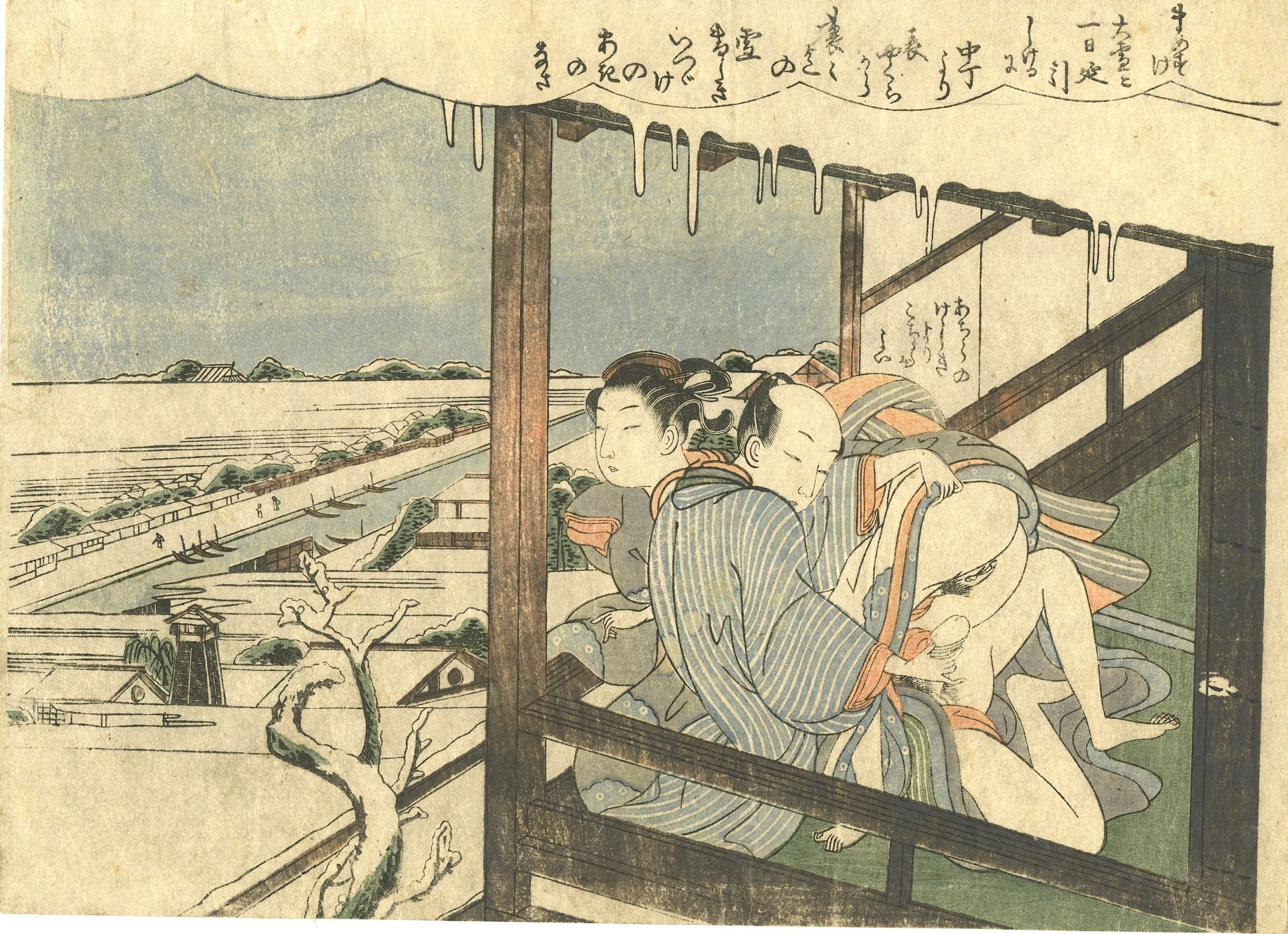 Unsigned print, attributed to Suzuki Harunobu. Erotic scene on open veranda with a winter landscape on background.
Unsigned print, attributed to Suzuki Harunobu. Erotic scene on open veranda with a winter landscape on background. -
 The Seven Gods of Good Luck in the Takarabune (ship of fortune) with a crane (the phoenix) above them.
The Seven Gods of Good Luck in the Takarabune (ship of fortune) with a crane (the phoenix) above them.Attributed to Katsukawa Shunshō, fl. 1726–92. Publisher: Uemura from Shiba (Edo). Marks "Publishers": U361|25-300: Uemura han (1793-1813). Marks "Artists, publishers...": Emiya Kichiemon (1688-1835). Artist signature absent. Looks very much like Pins #565 [p.223], but NOT the same. This exact design has not been found anywhere.

-

Iron tsuba of mokkō form decorated with inome (wild boar's eye) in openwork (sukashi) outlined with brass wire. The plate decorated with 3 concentric circular rows of brass dots in ten-zōgan. Center of the plate outlined with the inlaid circular brass wire (sen-zōgan). Some dots and the outline of inome on the face are missing.
Ōnin school. Unsigned. Mid Muromachi period, middle of the 15th century. Dimensions: 72.1 x 71.3 x 2.3 mm. -
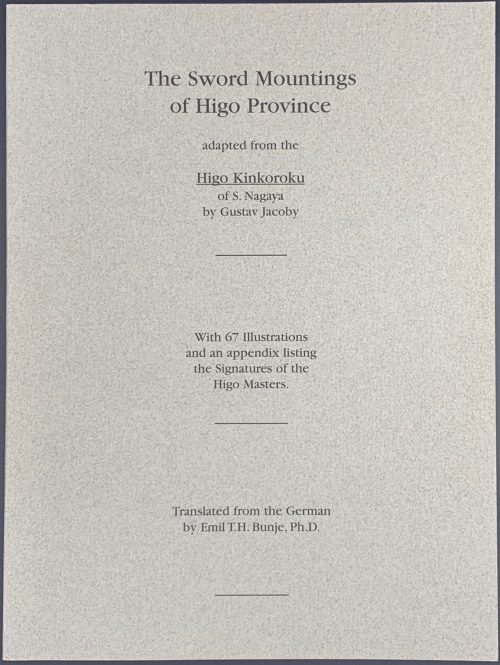
The sword mountings of Higo Province adapted from the Higo Kinkoroku of S. Nagaya by Gustav Jacoby, with 67 illustrations and an appendix listing the signatures of the Higo masters. Translated from the German by Emil T. H. Bunje, PhD.
Book size: 24.5 x 18.4 cm/
Softbound, original grey paper wrappers with black lettering.
Higo Kinkoroku, or Register of Metalworkers of Higo Province, published in 1902 in Tokyo by the Japanese Colonel Nagaya Shigena with a preface by viscount Nagaoka Moriyoshi, scion of the Hoshikawa family, Daimyo of Kumamoto in Higo Province.
Translated from the orignial: Die schwertzieraten der provinz Higo. Bearbeitet nach dem japanischen werke Higo Kinkoroku des S. Nagaya, von Gustav Jacoby. Mit 67 Abbildungen und einem Anhang: Die bezeichnungen der Higo-meister. 5. beiheft zum Jahrbuch der hamburgischen wissenschaftlichen anstalten. XXII. 1904. Hamburg, Lucas Gräfe & Sillem, 1905. - 62 p. illus., pl. [LIB-1947.2019] -
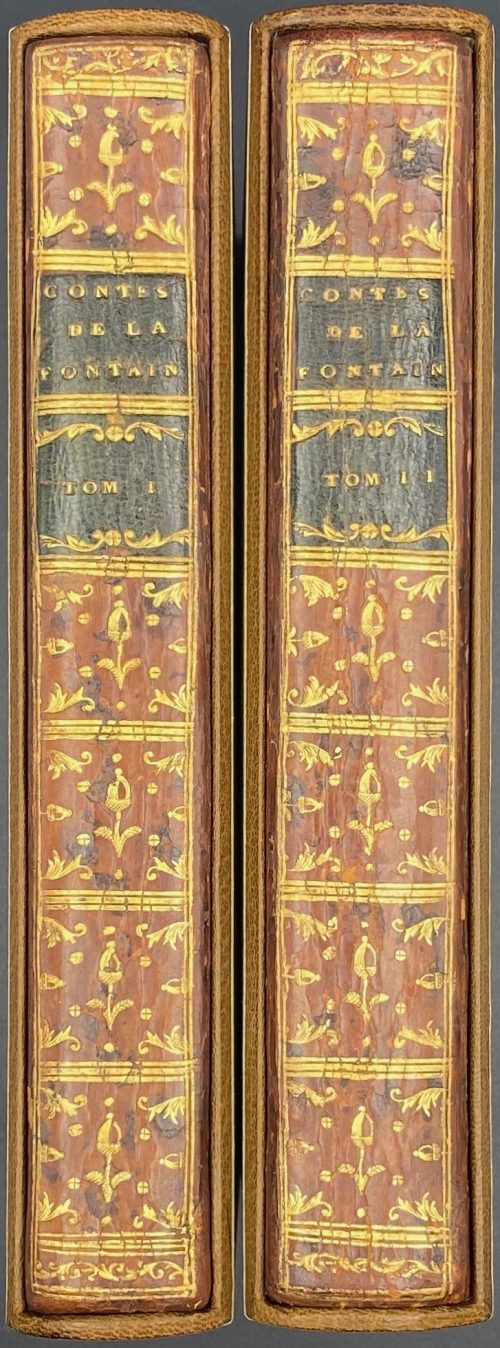 Two-volume edition, financed, arranged and managed by Fermiers généraux. Vol. 1. Title : CONTES | ET | NOUVELLES | EN VERS, | Par M. de La Fontaine. | TOME I. | {vignette} | A AMSTERDAM. | — | M. DCC. LXII. || Pagination: [2] – blanks [i, ii] – h.t. / blank, [iii, iv] – t.p. / blank, v-xiv, [1] 2–268 [269-70] – table, [4] – blanks, plus frontispiece by Fiquet after Rigault, t.p. vignette, vignette, headpiece, and 23 tailpieces by Choffard, 39 plates by various engravers after Charles Eisen. Vol. 2. Title: same but TOME II. Pagination: [2] – blanks] [i, ii] – h.t. / blank, [iii] iv-viii [1] 2–306 [307-10] – épitaphe / table, [4] – blanks, plus frontispiece by Fiquet after Vispré, t.p. vignette, vignette, headpiece, and 29 tailpieces by Choffard, and 42 plates after Charles Eisen (Ray only cite 41 plates). Binding: 2 volumes, 19.8 x 12.2 each, uniformly bound in full Spanish mottled calf, boards triple ruled in gilt, flat spine with triple bands, double ruled and tooled in gilt, black title labels lettered in gilt, all margins gilt, marbled end-papers, in cardboard slipcases, openings leathered. In vol. 1 a manuscript plate 4.8 x 8.2 cm pasted to page [1]: "Cette Édition est très rare n’y ayant | eu que 30 Exemplaires de livres, ou la figure principale dans le Cas de Conscience page 143 Tom 2 est nud tandis que dans les autres Éditions cette Figure est voilée par un feuillage".
Two-volume edition, financed, arranged and managed by Fermiers généraux. Vol. 1. Title : CONTES | ET | NOUVELLES | EN VERS, | Par M. de La Fontaine. | TOME I. | {vignette} | A AMSTERDAM. | — | M. DCC. LXII. || Pagination: [2] – blanks [i, ii] – h.t. / blank, [iii, iv] – t.p. / blank, v-xiv, [1] 2–268 [269-70] – table, [4] – blanks, plus frontispiece by Fiquet after Rigault, t.p. vignette, vignette, headpiece, and 23 tailpieces by Choffard, 39 plates by various engravers after Charles Eisen. Vol. 2. Title: same but TOME II. Pagination: [2] – blanks] [i, ii] – h.t. / blank, [iii] iv-viii [1] 2–306 [307-10] – épitaphe / table, [4] – blanks, plus frontispiece by Fiquet after Vispré, t.p. vignette, vignette, headpiece, and 29 tailpieces by Choffard, and 42 plates after Charles Eisen (Ray only cite 41 plates). Binding: 2 volumes, 19.8 x 12.2 each, uniformly bound in full Spanish mottled calf, boards triple ruled in gilt, flat spine with triple bands, double ruled and tooled in gilt, black title labels lettered in gilt, all margins gilt, marbled end-papers, in cardboard slipcases, openings leathered. In vol. 1 a manuscript plate 4.8 x 8.2 cm pasted to page [1]: "Cette Édition est très rare n’y ayant | eu que 30 Exemplaires de livres, ou la figure principale dans le Cas de Conscience page 143 Tom 2 est nud tandis que dans les autres Éditions cette Figure est voilée par un feuillage".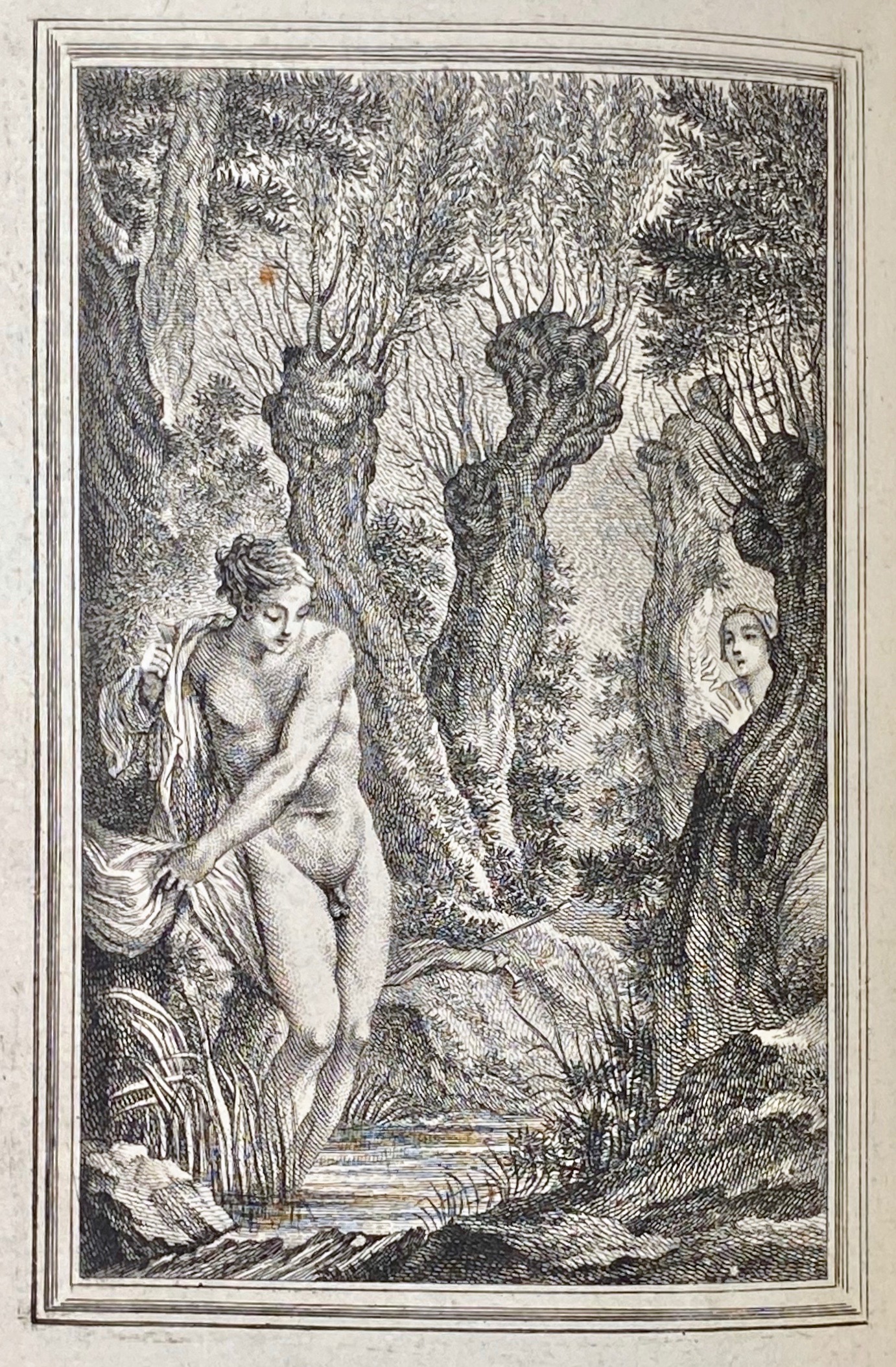
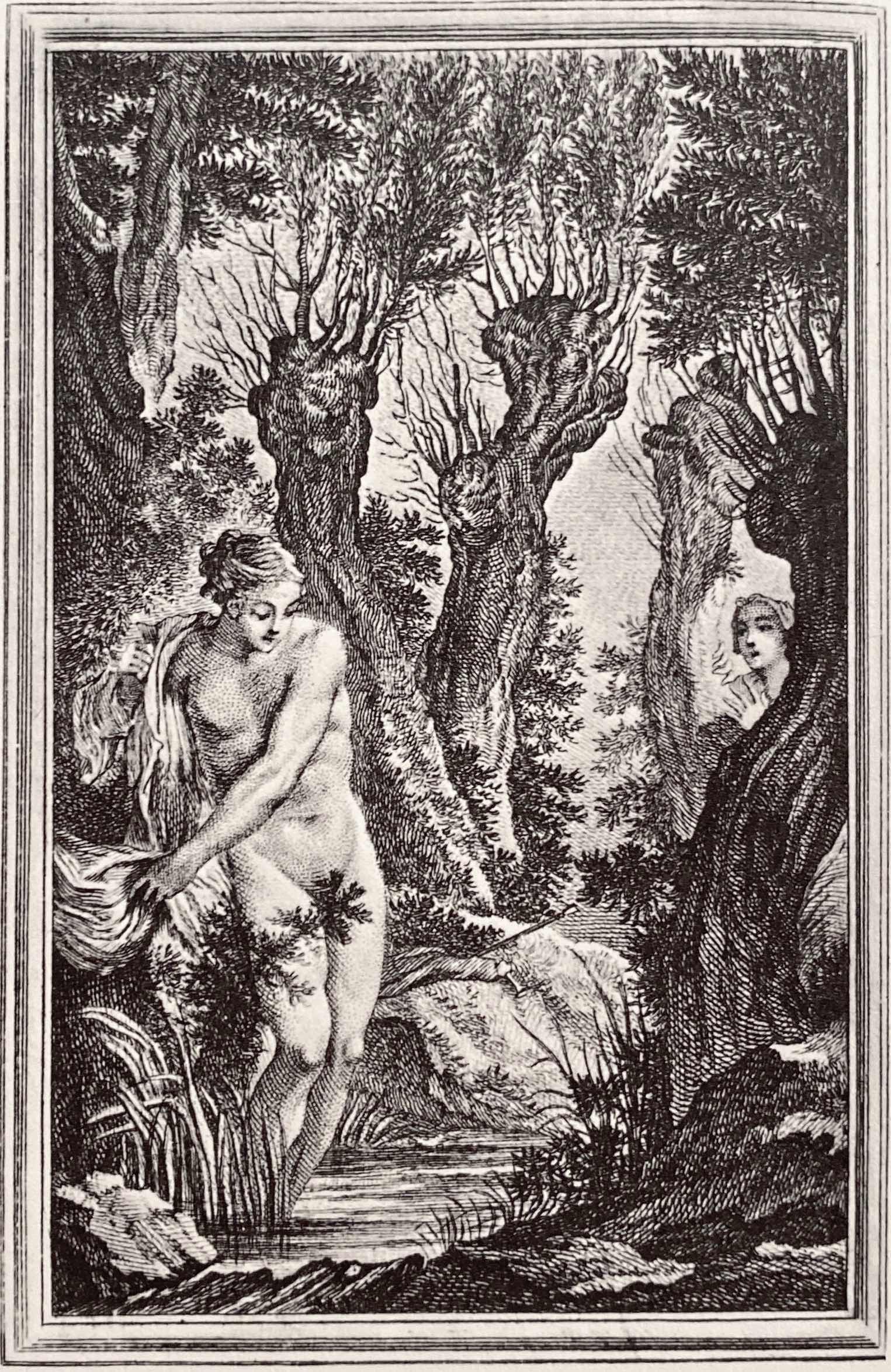 Contributors:
Jean de La Fontaine (French, 1621–1695) – author.
Fermiers généraux and Jean Baptiste Séroux d'Agincourt (French, 1730 – 1814) – publisher.
Joseph Gérard Barbou (French, 1723–1790) – printer.
Artists:
Charles Eisen (French, 1720 – 1778)
François Xavier Vispré (British-French, c.1730 – 1789 or after)
Hyacinthe Rigaud [Jacint Rigau-Ros i Serra] (Catalan-French, 1659 – 1743)
Engravers:
Joseph de Longueil (French, 1730 – 1792)
Noël Le Mire (French, 1724 – 1801)
Jean-Jacques André Le Veau (French, 1729 – 1786)
Jacques Aliamet (French, 1726 – 1788)
Jean Charles Baquoy (French, 1721 – 1777)
Pierre-Philippe Choffard (French, 1730 – 1809)
Jean Jacques Flipart (French, 1719 – 1782)
Louis Simon Lempereur (French, 1725 – 1796)
Jean Ouvrier (French, 1725 – 1784)
Contributors:
Jean de La Fontaine (French, 1621–1695) – author.
Fermiers généraux and Jean Baptiste Séroux d'Agincourt (French, 1730 – 1814) – publisher.
Joseph Gérard Barbou (French, 1723–1790) – printer.
Artists:
Charles Eisen (French, 1720 – 1778)
François Xavier Vispré (British-French, c.1730 – 1789 or after)
Hyacinthe Rigaud [Jacint Rigau-Ros i Serra] (Catalan-French, 1659 – 1743)
Engravers:
Joseph de Longueil (French, 1730 – 1792)
Noël Le Mire (French, 1724 – 1801)
Jean-Jacques André Le Veau (French, 1729 – 1786)
Jacques Aliamet (French, 1726 – 1788)
Jean Charles Baquoy (French, 1721 – 1777)
Pierre-Philippe Choffard (French, 1730 – 1809)
Jean Jacques Flipart (French, 1719 – 1782)
Louis Simon Lempereur (French, 1725 – 1796)
Jean Ouvrier (French, 1725 – 1784)
Étienne Ficquet (French 1719 – 1794)
Catalogue raisonné: Ray (French): №26, pp. 54-56; Cohen-DeRicci: 558-571; Lewine: 278-280. -
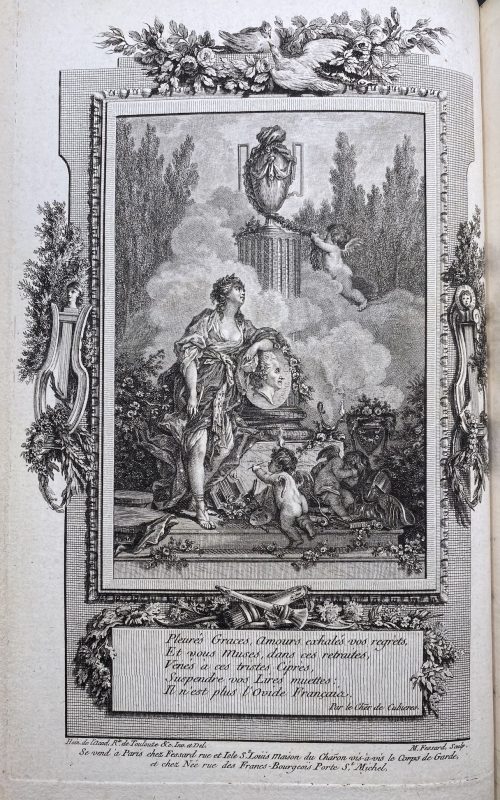 Title page: LES | BAISERS , | PRÉCÉDES | DU MOIS DE MAI, | POËME. | [vignette] | A LA HAYE , | Et se trouve à Paris | Chez Lambert , Imprimeur, rue de la Harpe. | Et Delalain , rue de la Comédie Françoise. | M. DCC. LXX Size: 8vo; 24.5 x 15.5 cm; Binding by Hippolyte Duru – stamp at the back of the front end paper DURU, 1855; full red calf, boards decorated in gilt, raised bands and gilt decorations in compartments, gilt lettering, AEG, peacock marbled end papers, text and illustrations printed on Holland paper. Collation: 2 ffls, engraved half-title by N. Ponce after Ch. Eisen, frontispiece by Etienne Fessard after Claude-Jean-Baptiste Hoin (French, 1750 – 1817) w/guard tissue, t.p. by J. Aliamet after Ch. Eisen, Réflexions préliminaires: A8, B4; 'Le Mois de Mai' half-title, imprim. note on verso, frontispice by De Longueil after Ch. Eisen w/guard tissue, A4 C-F(8) H4; 2bfls. Frontispiece by Etienne Fessard is unique in this edition. Pagination: [2] 3-24, [27]/28, 5/6, 31/32 31/34 11/12 37-119 [120], 22 head-pieces after Ch. Eisen and 22 end-pieces after Marillier, engraved by Baquoy, Binet, Delaunay, Lingée, De Longueil, Masquelier, Massard, and Née. Mistakes in pagination likely confirms first printing first edition. Catalogue raisonné: Cohen, De Ricci (1912): 308-311). Artists: Charles Eisen (French, 1720–1778); Clément Pierre Marillier (French, 1740–1808), and Claude-Jean-Baptiste Hoin (French, 1750–1817). Engravers: Jacques Aliamet (French, 1726–1788); Jean Charles Baquoy (French, 1721–1777); Louis Binet (French, 1744–about 1800); Nicolas Delaunay (French, 1739–1792); Etienne Fessard (French, 1714–1777); Charles Louis Lingée (French, 1748–1819); Joseph de Longueil (French, 1730–1792); Louis Joseph Masquelier (French, 1741–1811); Jean Massard (1740–1822); François Denis Née (French, 1735–1818); Nicholas Ponce (French, 1746–1831).
Title page: LES | BAISERS , | PRÉCÉDES | DU MOIS DE MAI, | POËME. | [vignette] | A LA HAYE , | Et se trouve à Paris | Chez Lambert , Imprimeur, rue de la Harpe. | Et Delalain , rue de la Comédie Françoise. | M. DCC. LXX Size: 8vo; 24.5 x 15.5 cm; Binding by Hippolyte Duru – stamp at the back of the front end paper DURU, 1855; full red calf, boards decorated in gilt, raised bands and gilt decorations in compartments, gilt lettering, AEG, peacock marbled end papers, text and illustrations printed on Holland paper. Collation: 2 ffls, engraved half-title by N. Ponce after Ch. Eisen, frontispiece by Etienne Fessard after Claude-Jean-Baptiste Hoin (French, 1750 – 1817) w/guard tissue, t.p. by J. Aliamet after Ch. Eisen, Réflexions préliminaires: A8, B4; 'Le Mois de Mai' half-title, imprim. note on verso, frontispice by De Longueil after Ch. Eisen w/guard tissue, A4 C-F(8) H4; 2bfls. Frontispiece by Etienne Fessard is unique in this edition. Pagination: [2] 3-24, [27]/28, 5/6, 31/32 31/34 11/12 37-119 [120], 22 head-pieces after Ch. Eisen and 22 end-pieces after Marillier, engraved by Baquoy, Binet, Delaunay, Lingée, De Longueil, Masquelier, Massard, and Née. Mistakes in pagination likely confirms first printing first edition. Catalogue raisonné: Cohen, De Ricci (1912): 308-311). Artists: Charles Eisen (French, 1720–1778); Clément Pierre Marillier (French, 1740–1808), and Claude-Jean-Baptiste Hoin (French, 1750–1817). Engravers: Jacques Aliamet (French, 1726–1788); Jean Charles Baquoy (French, 1721–1777); Louis Binet (French, 1744–about 1800); Nicolas Delaunay (French, 1739–1792); Etienne Fessard (French, 1714–1777); Charles Louis Lingée (French, 1748–1819); Joseph de Longueil (French, 1730–1792); Louis Joseph Masquelier (French, 1741–1811); Jean Massard (1740–1822); François Denis Née (French, 1735–1818); Nicholas Ponce (French, 1746–1831). -
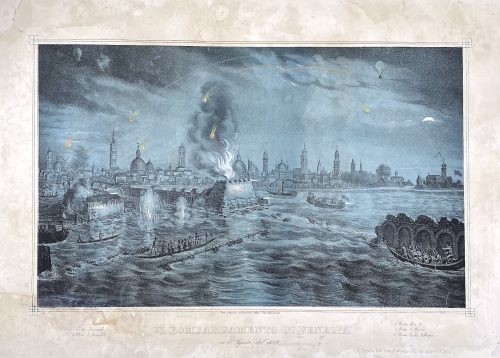 Quaritch's description: Single sheet (435 x 625 mm); coloured lithograph by Kirchmayr after a drawing by M. Fontana; hand-painted details; signed to lower left ‘M. Fon[tana]’ and to lower right ‘M. Fontana Edit. Prop. S. Giacomo dall’Orio in Isola N°.1481’; lower margin with the title ‘Il bombardamento di Venezia nell’Agosto 1849’ and key; restored tears in many places, especially along upper and lower blank margins, some affecting print; losses to lower left corner, affecting a small portion of the print, ruled border, and key, restored and re-drawn where needed; loss to the upper left corner of blank margin; two small areas of restoration to the centre of upper blank margin; the whole sheet backed; nevertheless a remarkable survival. Exceedingly rare and striking lithograph of Venice as seen from Fusina, depicting the first ever aerial bombardment in history. The bombardment took place in 1849, under the orders of Field Marshal Josef Radetzky (1766–1858), to quell the revolts that had started the previous year during the First Italian War of Independence. This curious and little-known action was the brainchild of Colonel Benno Uchatius, a brilliant young officer in the Austro-Hungarian Artillery. After long months of unsuccessful siege, Uchatius decided to deploy an unusual weapon: a hot air balloon able to bomb the city from above. Having calculated the wind speed and direction and evaluated the requisite dimensions of the hot-air balloon, Uchatius set up a workshop near Mestre, where a group of engineers and craftsmen began to manufacture a balloon equipped with a large wicker basket which could transport two crewmen and approximately one hundred kilograms of small long-fuse devices (metal spheres filled with gunpowder, pitch, oil and five hundred rifle buckshot). The initial trials, however, proved to be a disaster, because the balloon would drift off course, making it impossible to accurately deploy the bombs. Uchatius then hit upon the idea of using several smaller unmanned balloons roped together. These were to be launched over the city and, using the position of the first ‘pilot’ balloon, which was unarmed, the Austrians could calculate the correct fuse settings for the bombs. The ‘bomber’ balloons had a cloth envelope of one hundred cubic metres and a reduced load of about twenty kilograms of ordnance. According to Uchatius’ calculations, the line of balloons, launched from Mestre, would reach the lagoon city in thirty-five to forty minutes, carried by the north-west wind. In July 1849, a first launch was attempted, but when a breeze began to blow from the sea some of the balloons broke the connecting ropes and floated away, while others settled in the water in front of the northern part of the city, where a curious crowd of Venetians observed the failure of the enterprise and commented colourfully on the ‘buffoonery of Radetzky’. Uchatius’ second attempt, which is depicted in this lithograph, was also largely unsuccessful: only a few of the unmanned bomber balloons reached their target, and some even drifted back over the Austrian lines. Uchatius, having accomplished the first ever aerial bombardment, and having designed the first ever military ‘drones’, was forced to abandon the project permanently. Another fascinating aspect of this work is the vantage point used to depict the city of Venice, seen here from Fusina, a very rare viewpoint that makes this piece even more remarkable. We were unable to locate any copies in any institution or bibliography. G. Kirchmayr (fl. mid-19th century) is mentioned at British Museum database as "Lithographer active in Venice; related to Venetian painter Cherubino Kirchmayr (b. 1848)?" However, I was not able to find that name on the print. Not much is known of M. Fontana either.
Quaritch's description: Single sheet (435 x 625 mm); coloured lithograph by Kirchmayr after a drawing by M. Fontana; hand-painted details; signed to lower left ‘M. Fon[tana]’ and to lower right ‘M. Fontana Edit. Prop. S. Giacomo dall’Orio in Isola N°.1481’; lower margin with the title ‘Il bombardamento di Venezia nell’Agosto 1849’ and key; restored tears in many places, especially along upper and lower blank margins, some affecting print; losses to lower left corner, affecting a small portion of the print, ruled border, and key, restored and re-drawn where needed; loss to the upper left corner of blank margin; two small areas of restoration to the centre of upper blank margin; the whole sheet backed; nevertheless a remarkable survival. Exceedingly rare and striking lithograph of Venice as seen from Fusina, depicting the first ever aerial bombardment in history. The bombardment took place in 1849, under the orders of Field Marshal Josef Radetzky (1766–1858), to quell the revolts that had started the previous year during the First Italian War of Independence. This curious and little-known action was the brainchild of Colonel Benno Uchatius, a brilliant young officer in the Austro-Hungarian Artillery. After long months of unsuccessful siege, Uchatius decided to deploy an unusual weapon: a hot air balloon able to bomb the city from above. Having calculated the wind speed and direction and evaluated the requisite dimensions of the hot-air balloon, Uchatius set up a workshop near Mestre, where a group of engineers and craftsmen began to manufacture a balloon equipped with a large wicker basket which could transport two crewmen and approximately one hundred kilograms of small long-fuse devices (metal spheres filled with gunpowder, pitch, oil and five hundred rifle buckshot). The initial trials, however, proved to be a disaster, because the balloon would drift off course, making it impossible to accurately deploy the bombs. Uchatius then hit upon the idea of using several smaller unmanned balloons roped together. These were to be launched over the city and, using the position of the first ‘pilot’ balloon, which was unarmed, the Austrians could calculate the correct fuse settings for the bombs. The ‘bomber’ balloons had a cloth envelope of one hundred cubic metres and a reduced load of about twenty kilograms of ordnance. According to Uchatius’ calculations, the line of balloons, launched from Mestre, would reach the lagoon city in thirty-five to forty minutes, carried by the north-west wind. In July 1849, a first launch was attempted, but when a breeze began to blow from the sea some of the balloons broke the connecting ropes and floated away, while others settled in the water in front of the northern part of the city, where a curious crowd of Venetians observed the failure of the enterprise and commented colourfully on the ‘buffoonery of Radetzky’. Uchatius’ second attempt, which is depicted in this lithograph, was also largely unsuccessful: only a few of the unmanned bomber balloons reached their target, and some even drifted back over the Austrian lines. Uchatius, having accomplished the first ever aerial bombardment, and having designed the first ever military ‘drones’, was forced to abandon the project permanently. Another fascinating aspect of this work is the vantage point used to depict the city of Venice, seen here from Fusina, a very rare viewpoint that makes this piece even more remarkable. We were unable to locate any copies in any institution or bibliography. G. Kirchmayr (fl. mid-19th century) is mentioned at British Museum database as "Lithographer active in Venice; related to Venetian painter Cherubino Kirchmayr (b. 1848)?" However, I was not able to find that name on the print. Not much is known of M. Fontana either. -
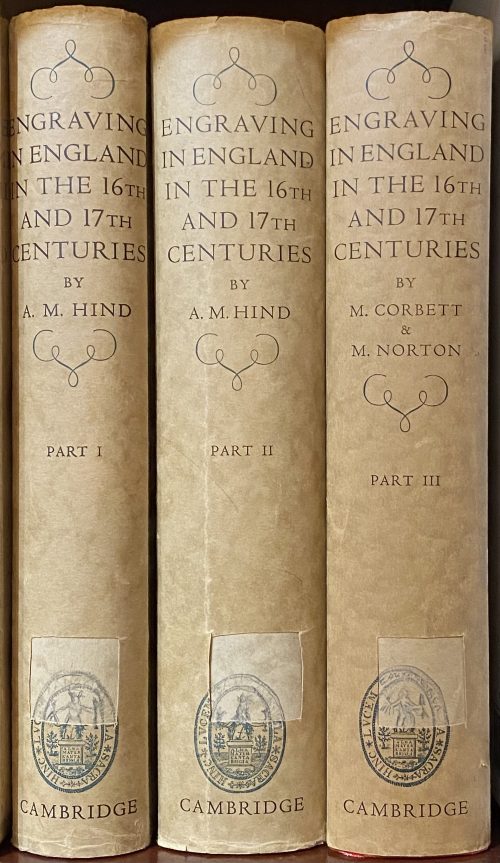 A three-volume set. VOL. 1: ENGRAVING IN ENGLAND | IN THE | SIXTEENTH AND SEVENTEENTH CENTURIES | A DESCRIPTIVE CATALOGUE | WITH INTRODUCTIONS | BY | ARTHUR M HIND | Sometime Keeper of Prints and Drawings in the British Museum | and Slade Professor of Fine Art in the University of Oxford | PART I | THE TUDOR PERIOD | WITH 319 ILLUSTRATIONS | {The coat of arms of the University of Cambridge} | CAMBRIDGE | AT THE UNIVERSITY PRESS | 1952|| Pagination: ffl, [i-vi] – h.t. / blank, frontis., t.p. / colophon, dedication / blank; vii-xxx; 1-333 [334 blank] [2] – the plates / blank; 1-156 pp. of plates. Collation: a-b8, 1-218 + 78 leaves of plates at the end. VOL. 2: ENGRAVING IN ENGLAND | IN THE | SIXTEENTH AND SEVENTEENTH CENTURIES | A DESCRIPTIVE CATALOGUE | WITH INTRODUCTIONS | BY | ARTHUR M HIND | Sometime Keeper of Prints and Drawings in the British Museum | and Slade Professor of Fine Art in the University of Oxford | PART II | THE REIGN OF JAMES I | WITH 618 ILLUSTRATIONS| {The coat of arms of the University of Cambridge} | CAMBRIDGE | AT THE UNIVERSITY PRESS | 1955|| Pagination: [i-iv] – h.t. / blank, t.p. / colophon; v-xiv [xv] [xvi blank]; 1-396 [397] [398 blank] [2] – the plates / blank; 1-252 pp. of plates. Collation: a-b8, 1-268 + 126 leaves of plates at the end. VOL. 3: ENGRAVING IN ENGLAND | IN THE | SIXTEENTH AND SEVENTEENTH CENTURIES | A DESCRIPTIVE CATALOGUE | WITH INTRODUCTIONS | PART III | THE REIGN OF CHARLES I | WITH 466 ILLUSTRATIONS | COMPILED FROM THE NOTES OF | THE LATE A. M. HIND | BY | MARGERY CORBETT & MICHAEL NORTON | {The coat of arms of the University of Cambridge} | CAMBRIDGE | AT THE UNIVERSITY PRESS | 1964|| Pagination: [i-vi] – h.t. / blank, frontis., t.p. / colophon, dedication / blank; vii-xxx; 1-333 [334 blank] [2] – the plates / blank; 1-214 pp. of plates. Collation: [a]8, 1-258 + 107 leaves of plates at the end. Each of three volumes bound in red cloth with gilt lettering to spine, residuals of library stickers, dark spotting to the top and lateral edges; tan DJ with title lettering in a frame to front, lettering to spine, advert. to back, with cut off stickers to spine; ‘The Francis Bacon Foundation’ ink stamp to front pastedown.
A three-volume set. VOL. 1: ENGRAVING IN ENGLAND | IN THE | SIXTEENTH AND SEVENTEENTH CENTURIES | A DESCRIPTIVE CATALOGUE | WITH INTRODUCTIONS | BY | ARTHUR M HIND | Sometime Keeper of Prints and Drawings in the British Museum | and Slade Professor of Fine Art in the University of Oxford | PART I | THE TUDOR PERIOD | WITH 319 ILLUSTRATIONS | {The coat of arms of the University of Cambridge} | CAMBRIDGE | AT THE UNIVERSITY PRESS | 1952|| Pagination: ffl, [i-vi] – h.t. / blank, frontis., t.p. / colophon, dedication / blank; vii-xxx; 1-333 [334 blank] [2] – the plates / blank; 1-156 pp. of plates. Collation: a-b8, 1-218 + 78 leaves of plates at the end. VOL. 2: ENGRAVING IN ENGLAND | IN THE | SIXTEENTH AND SEVENTEENTH CENTURIES | A DESCRIPTIVE CATALOGUE | WITH INTRODUCTIONS | BY | ARTHUR M HIND | Sometime Keeper of Prints and Drawings in the British Museum | and Slade Professor of Fine Art in the University of Oxford | PART II | THE REIGN OF JAMES I | WITH 618 ILLUSTRATIONS| {The coat of arms of the University of Cambridge} | CAMBRIDGE | AT THE UNIVERSITY PRESS | 1955|| Pagination: [i-iv] – h.t. / blank, t.p. / colophon; v-xiv [xv] [xvi blank]; 1-396 [397] [398 blank] [2] – the plates / blank; 1-252 pp. of plates. Collation: a-b8, 1-268 + 126 leaves of plates at the end. VOL. 3: ENGRAVING IN ENGLAND | IN THE | SIXTEENTH AND SEVENTEENTH CENTURIES | A DESCRIPTIVE CATALOGUE | WITH INTRODUCTIONS | PART III | THE REIGN OF CHARLES I | WITH 466 ILLUSTRATIONS | COMPILED FROM THE NOTES OF | THE LATE A. M. HIND | BY | MARGERY CORBETT & MICHAEL NORTON | {The coat of arms of the University of Cambridge} | CAMBRIDGE | AT THE UNIVERSITY PRESS | 1964|| Pagination: [i-vi] – h.t. / blank, frontis., t.p. / colophon, dedication / blank; vii-xxx; 1-333 [334 blank] [2] – the plates / blank; 1-214 pp. of plates. Collation: [a]8, 1-258 + 107 leaves of plates at the end. Each of three volumes bound in red cloth with gilt lettering to spine, residuals of library stickers, dark spotting to the top and lateral edges; tan DJ with title lettering in a frame to front, lettering to spine, advert. to back, with cut off stickers to spine; ‘The Francis Bacon Foundation’ ink stamp to front pastedown. -
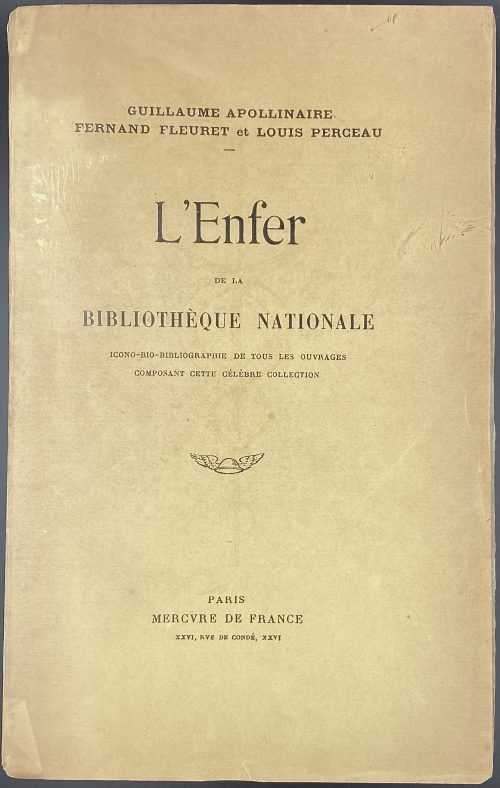 Title: GUILLAUME APOLLINAIRE | FERNAND FLEURET LOUIS PERCEAU | L'Enfer | DE LA | BIBLIOTHÈQUE NATIONALE | ICONO-BIO-BIBLIOGRAPHIE | DESCRIPTIVE, CRITIQUE ET RAISONNÉE, | COMPLÈTE A CE JOUR | DE TOUS LES OUVRAGES COMPOSANT CETTE CÉLÈBRE COLLECTION | AVEC UN INDEX ALPHABÉTIQUE | DES TITRES ET NOMS D'AUTEURS | PARIS | MERCVRE DE FRANCE | XXVI, RVE DE CONDÉ, XXVI | MCMXII || Pagination: ffl, [1-5] 6-415 [416], bfl. Collation: [1]8 2-268. Binding: Original tan wrappers, lettering to covers and spine. Edition: First edition of which this is №952. Ref.: BnF
Title: GUILLAUME APOLLINAIRE | FERNAND FLEURET LOUIS PERCEAU | L'Enfer | DE LA | BIBLIOTHÈQUE NATIONALE | ICONO-BIO-BIBLIOGRAPHIE | DESCRIPTIVE, CRITIQUE ET RAISONNÉE, | COMPLÈTE A CE JOUR | DE TOUS LES OUVRAGES COMPOSANT CETTE CÉLÈBRE COLLECTION | AVEC UN INDEX ALPHABÉTIQUE | DES TITRES ET NOMS D'AUTEURS | PARIS | MERCVRE DE FRANCE | XXVI, RVE DE CONDÉ, XXVI | MCMXII || Pagination: ffl, [1-5] 6-415 [416], bfl. Collation: [1]8 2-268. Binding: Original tan wrappers, lettering to covers and spine. Edition: First edition of which this is №952. Ref.: BnF -
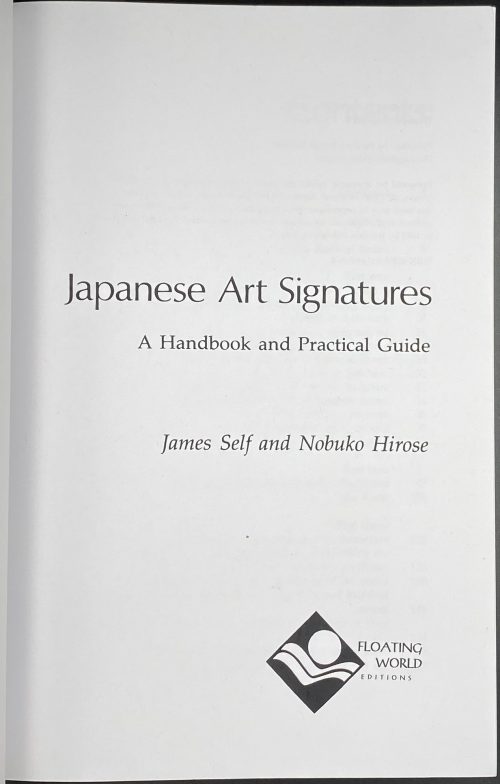 Title: Japanese Art Signatures | A Handbook and Practical Guide | James Self and Nobiko Hirose | {publisher’s device} FLOATING | WORLD | EDITIONS || Pp.: [2] 3-399 [400]. 1st Floating World edition, 2003, 3rd printing, 2011. 1st edition in 1987 by Bamboo Publishing, Ltd. by Charles E. Tuttle Company, Rutland and Tokyo. Binding: Original blue wrappers with white lettering to both covers and spine, in yellow frames.
Title: Japanese Art Signatures | A Handbook and Practical Guide | James Self and Nobiko Hirose | {publisher’s device} FLOATING | WORLD | EDITIONS || Pp.: [2] 3-399 [400]. 1st Floating World edition, 2003, 3rd printing, 2011. 1st edition in 1987 by Bamboo Publishing, Ltd. by Charles E. Tuttle Company, Rutland and Tokyo. Binding: Original blue wrappers with white lettering to both covers and spine, in yellow frames. -
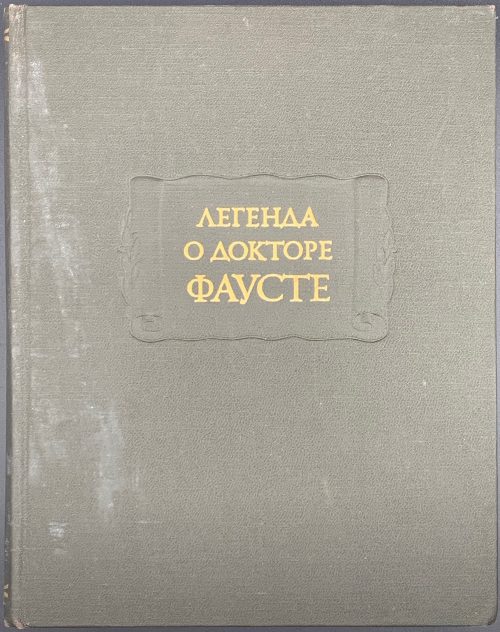 Title (black lettering, red elements): ЛЕГЕНДА | О ДОКТОРЕ | ФАУСТЕ | {element} | ИЗДАНИЕ ПОДГОТОВИЛ | В. М. ЖИРМУНСКИЙ | ВТОРОЕ, ИСПРАВЛЕННОЕ ИЗДАНИЕ | ИЗДАТЕЛЬСТВО «НАУКА» | МОСКВА 1978 || Pagination:[1-5] 6-421 [3]; +3 leaves of plates. Collation: 8vo; [1]8 2-278. Binding: 22 x 17.5 cm, serial green buckram blind-stamped with a scroll adorned with gold lettering to board and spine. Contents:
Title (black lettering, red elements): ЛЕГЕНДА | О ДОКТОРЕ | ФАУСТЕ | {element} | ИЗДАНИЕ ПОДГОТОВИЛ | В. М. ЖИРМУНСКИЙ | ВТОРОЕ, ИСПРАВЛЕННОЕ ИЗДАНИЕ | ИЗДАТЕЛЬСТВО «НАУКА» | МОСКВА 1978 || Pagination:[1-5] 6-421 [3]; +3 leaves of plates. Collation: 8vo; [1]8 2-278. Binding: 22 x 17.5 cm, serial green buckram blind-stamped with a scroll adorned with gold lettering to board and spine. Contents:- Исторические и легендарные свидетельства о докторе Фаусте / Пер. С. А. Акулянц.
- Народная книга: История о докторе Иоганне Фаусте, знаменитом чародее и чернокнижнике / Пер. Р. В. Френкель.
- Свидетельства о постановке народной драмы и кукольной комедии / Пер. С. А. Акулянц
- Кукольные комедии / Пер. H. A. Сигал: (1) Доктор Иоганн Фауст; (2) Доктор Фауст, или Великий Негромант; (3) Иоганнес Фауст.
- Кристофер Марло. Трагическая история доктора Фауста / Пер. H. H. Амосовой.
- «Фауст» Лессинга / Пер. В. Е. Гаккель-Аренс.
- Комментарии: В. М. Жирмунский. История легенды о Фаусте.
- Примечания / Сост. В. М. Жирмунский; к «Фаусту» Марло — H. H. Амосова.
-
![[Charles Octave Moget, Joseph Décembre]. Sempronius. Histoire de la Commune de Paris en 1871. Paris, Décembre-Alonnier, [1871]. – pp: [i, ii - ht, imprim.] iii, iv - t.p., blank] [v - table] vi-viii (viii numbered iii), [1] 2 [3] 4-267 [268 blank] [1] 2-12 advert. [Pseudonym of Charles Octave Moget and Joseph Décembre]. Charles Octave Moget, dit Octave Féré (1815-1875); Joseph Décembre, dit Décembre-Allonier (1836 – 1906).](https://varshavskycollection.com/wp-content/uploads/2021/02/LIB-2445.2020-a-1-500x745.jpeg) Front publisher’s yellow wrapper, in a double frame: SEMPRONIUS | HISTOIRE | DE LA | COMMUNE DE PARIS | EN 1871 | La période impériale. – La Révolution du 4 Septembre. – Le | gouvernement de la Défense nationale. – Le Parti républicain | et le Parti socialiste. – L'Association internationale des | travailleurs. – Menées du parti socialiste. – La Commune en 1793. – Le 31 octobre et le 22 janvier. – La Capitulation de | Paris. – Le 18 mars. – L'Assassinat des généraux Clément | Thomas et Lecomte. – Le Comité central de la Garde nationale. | – La Commune ; – Ses Agissement. – Son Budget. – La | Terreur. – Insolence des Fédérés. – Les journaux. – Les Otages. | – Les Opérations militaires. – Les Fusillades. – Les Vols. – Les | Barricades. – Les Incendies. – Documents officiels de la Commune. | TROISIÈME ÉDITION | PARIS, DECEMBRE - ALONNIER, LIBRAIRE-ÉDITEUR | 20 RUE SEGUR, 20 | PRÉS DE LA PLACE SAINT-ANDR -DES-ARTS || Title page: similar to the cover with no frame. Pagination: front wrapper, [2] – h.t. / imprint., [2] – t.p. / blank, [i] – table de matières, vi (i.e. ii), vii (i.e. iii), iii (i.e. iv), [1] 2-267 [268 blank], [1] 2-12 – publisher's advert., back wrapper. Collation : 18mo ; π4, 1-1518, ß6. Binding: 18.5 x 12 cm; softcover; original yellow wrappers, black lettering to covers and spine; almost disbound. Réferences: Le Quillec (1997): 2324; University of Sussex > Paris Commune Collection. Author of the book: "SEMPRONIUS" was in reality two men: Moget, Charles Octave [Féré, Octave] (French, 1815 – 1875) and Décembre, Joseph [Décembre-Allonier] (French, 1836 – 1906).
Front publisher’s yellow wrapper, in a double frame: SEMPRONIUS | HISTOIRE | DE LA | COMMUNE DE PARIS | EN 1871 | La période impériale. – La Révolution du 4 Septembre. – Le | gouvernement de la Défense nationale. – Le Parti républicain | et le Parti socialiste. – L'Association internationale des | travailleurs. – Menées du parti socialiste. – La Commune en 1793. – Le 31 octobre et le 22 janvier. – La Capitulation de | Paris. – Le 18 mars. – L'Assassinat des généraux Clément | Thomas et Lecomte. – Le Comité central de la Garde nationale. | – La Commune ; – Ses Agissement. – Son Budget. – La | Terreur. – Insolence des Fédérés. – Les journaux. – Les Otages. | – Les Opérations militaires. – Les Fusillades. – Les Vols. – Les | Barricades. – Les Incendies. – Documents officiels de la Commune. | TROISIÈME ÉDITION | PARIS, DECEMBRE - ALONNIER, LIBRAIRE-ÉDITEUR | 20 RUE SEGUR, 20 | PRÉS DE LA PLACE SAINT-ANDR -DES-ARTS || Title page: similar to the cover with no frame. Pagination: front wrapper, [2] – h.t. / imprint., [2] – t.p. / blank, [i] – table de matières, vi (i.e. ii), vii (i.e. iii), iii (i.e. iv), [1] 2-267 [268 blank], [1] 2-12 – publisher's advert., back wrapper. Collation : 18mo ; π4, 1-1518, ß6. Binding: 18.5 x 12 cm; softcover; original yellow wrappers, black lettering to covers and spine; almost disbound. Réferences: Le Quillec (1997): 2324; University of Sussex > Paris Commune Collection. Author of the book: "SEMPRONIUS" was in reality two men: Moget, Charles Octave [Féré, Octave] (French, 1815 – 1875) and Décembre, Joseph [Décembre-Allonier] (French, 1836 – 1906). -
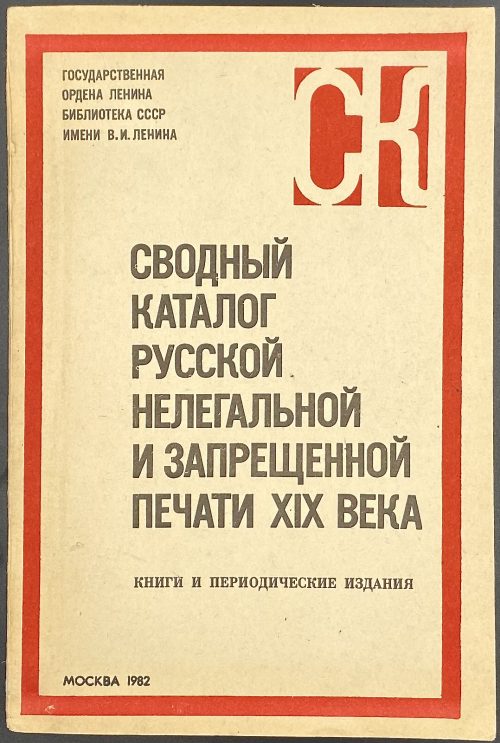 Front wrapper (in black and red in a red frame): ГОСУДАРСТВЕННАЯ ОРДЕНА ЛЕНИНА БИБЛИОТЕКА СССР | ИМЕНИ В. И. ЛЕНИНА — {СК} (white stylized letters on red background) | СВОДНЫЙ | КАТАЛОГ | РУССКОЙ | НЕЛЕГАЛЬНОЙ | И ЗАПРЕЩЕННОЙ | ПЕЧАТИ XIX ВЕКА | КНИГИ И ПЕРИОДИЧЕСКИЕ ИЗДАНИЯ | МОСКВА 1982 || Title page: ГОСУДАРСТВЕННАЯ ОРДЕНА ЛЕНИНА БИБЛИОТЕКА СССР| СВОДНЫЙ КАТАЛОГ | РУССКОЙ НЕЛЕГАЛЬНОЙ | И ЗАПРЕЩЕННОЙ ПЕЧАТИ | XIX ВЕКА | КНИГИ И ПЕРИОДИЧЕСКИЕ ИЗДАНИЯ | 2-Е ДОПОЛНЕННОЕ И ПЕРЕРАБОТАННОЕ ИЗДАНИЕ | Часть 3. Приложения. | Вспомогательные указатели. Список источников | МОСКВА 1982 || Publisher’s wrappers, 21.5 x 14.5 cm, lettering to front and spine; pagination: [2] – t.p. / imprint, 3-242 [4] – incl. contents, imprint, and errata, [2] – blanks. Print run 1,250 copies. Науч. ред.: Итенберг, Борис Самуилович (Russian, 1921 – 2016). «Сводный каталог русской нелегальной и запрещенной печати XIX века. Книги и периодические издания» состоит из трех частей: Часть 1. Книги А–М. (№ 1–1158) [LIB-2648.2021] Часть 2. Книги Н–Я. Периодические издания (№ 1159–2576) [LIB-2660.2021] Часть 3-я. Приложения. Вспомогательные указатели. Список источников.
Front wrapper (in black and red in a red frame): ГОСУДАРСТВЕННАЯ ОРДЕНА ЛЕНИНА БИБЛИОТЕКА СССР | ИМЕНИ В. И. ЛЕНИНА — {СК} (white stylized letters on red background) | СВОДНЫЙ | КАТАЛОГ | РУССКОЙ | НЕЛЕГАЛЬНОЙ | И ЗАПРЕЩЕННОЙ | ПЕЧАТИ XIX ВЕКА | КНИГИ И ПЕРИОДИЧЕСКИЕ ИЗДАНИЯ | МОСКВА 1982 || Title page: ГОСУДАРСТВЕННАЯ ОРДЕНА ЛЕНИНА БИБЛИОТЕКА СССР| СВОДНЫЙ КАТАЛОГ | РУССКОЙ НЕЛЕГАЛЬНОЙ | И ЗАПРЕЩЕННОЙ ПЕЧАТИ | XIX ВЕКА | КНИГИ И ПЕРИОДИЧЕСКИЕ ИЗДАНИЯ | 2-Е ДОПОЛНЕННОЕ И ПЕРЕРАБОТАННОЕ ИЗДАНИЕ | Часть 3. Приложения. | Вспомогательные указатели. Список источников | МОСКВА 1982 || Publisher’s wrappers, 21.5 x 14.5 cm, lettering to front and spine; pagination: [2] – t.p. / imprint, 3-242 [4] – incl. contents, imprint, and errata, [2] – blanks. Print run 1,250 copies. Науч. ред.: Итенберг, Борис Самуилович (Russian, 1921 – 2016). «Сводный каталог русской нелегальной и запрещенной печати XIX века. Книги и периодические издания» состоит из трех частей: Часть 1. Книги А–М. (№ 1–1158) [LIB-2648.2021] Часть 2. Книги Н–Я. Периодические издания (№ 1159–2576) [LIB-2660.2021] Часть 3-я. Приложения. Вспомогательные указатели. Список источников. -
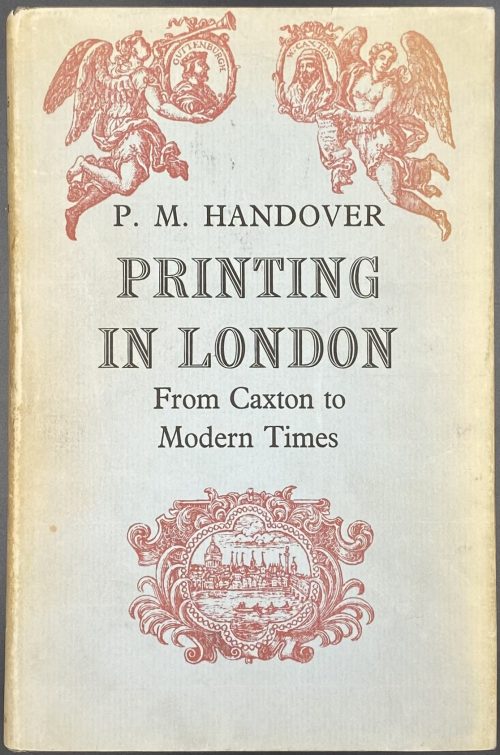 Dust jacket (black lettering, sanguine vignettes over light blue) : {vignette} | P. M. HANDOVER | PRINTING | IN LONDON | from Caxton to | Modern Times | {vignette} || Title page: PRINTING IN LONDON | FROM 1476 TO MODERN TIMES | COMPETITIVE PRACTICE AND | TECHNICAL INVENTION | IN THE TRADE OF | BOOK AND BIBLE PRINTING | PERIODICAL PRODUCTION | JOBBING &C |—| P. M. HANDOVER | M.A. F.R.HIST.S. | HARVARD UNIVERSITY PRESS | CAMBRIDGE, MASSACHUSETTS | 1960 || Pagination: [1, 2] – h.t. / blank ; frontispiece; [3, 4] – t.p. / imprint; [5, 6] – dedication / blank; [7] 8-224, inset: 7 sheets of plates between pp. 112-113 extraneous to collation, other illustrations in text; insert: invitation card "Publication date JUL 11 1960 Handover". Collation: 8vo; [A]8 B-O8. Binding: publisher’s blue cloth, red label to spine, silver lettering, DJ.
Dust jacket (black lettering, sanguine vignettes over light blue) : {vignette} | P. M. HANDOVER | PRINTING | IN LONDON | from Caxton to | Modern Times | {vignette} || Title page: PRINTING IN LONDON | FROM 1476 TO MODERN TIMES | COMPETITIVE PRACTICE AND | TECHNICAL INVENTION | IN THE TRADE OF | BOOK AND BIBLE PRINTING | PERIODICAL PRODUCTION | JOBBING &C |—| P. M. HANDOVER | M.A. F.R.HIST.S. | HARVARD UNIVERSITY PRESS | CAMBRIDGE, MASSACHUSETTS | 1960 || Pagination: [1, 2] – h.t. / blank ; frontispiece; [3, 4] – t.p. / imprint; [5, 6] – dedication / blank; [7] 8-224, inset: 7 sheets of plates between pp. 112-113 extraneous to collation, other illustrations in text; insert: invitation card "Publication date JUL 11 1960 Handover". Collation: 8vo; [A]8 B-O8. Binding: publisher’s blue cloth, red label to spine, silver lettering, DJ. -
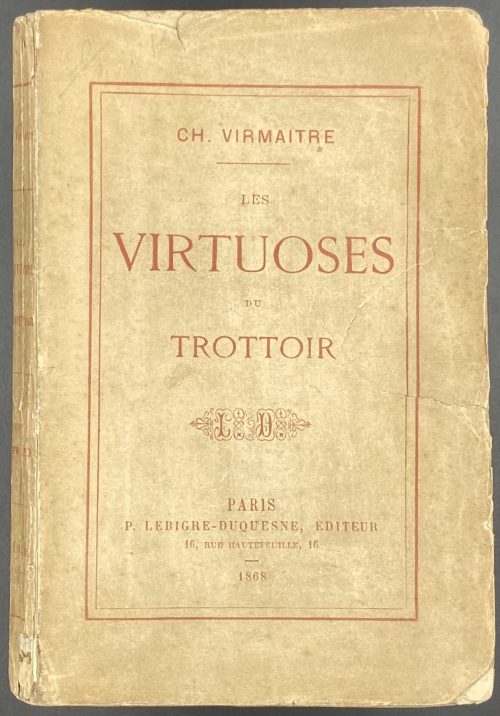 Cover: Ch. Virmaitre | LES | VIRTUOSES | DU | TROTTOIR | {publisher’s device} | PARIS | P. LEBIGRE-DUQUESNE, ÉDITEUR | 16, RUE HAUTEFEUILLE, 16 | 1868 || Title: Similar. Imprint: De Rouge Frères, Dunon et Fresné (Paris). Pagination: [1-7] 8-161 [162], [2] – table, [2] – advert., [14]; 90 leaves total; publisher’s cream wrappers with red lettering in double frame. Collation: 12mo in 6th; [1]-136, 1412. Charles Virmaître (French, 1835 – 1903).
Cover: Ch. Virmaitre | LES | VIRTUOSES | DU | TROTTOIR | {publisher’s device} | PARIS | P. LEBIGRE-DUQUESNE, ÉDITEUR | 16, RUE HAUTEFEUILLE, 16 | 1868 || Title: Similar. Imprint: De Rouge Frères, Dunon et Fresné (Paris). Pagination: [1-7] 8-161 [162], [2] – table, [2] – advert., [14]; 90 leaves total; publisher’s cream wrappers with red lettering in double frame. Collation: 12mo in 6th; [1]-136, 1412. Charles Virmaître (French, 1835 – 1903). -
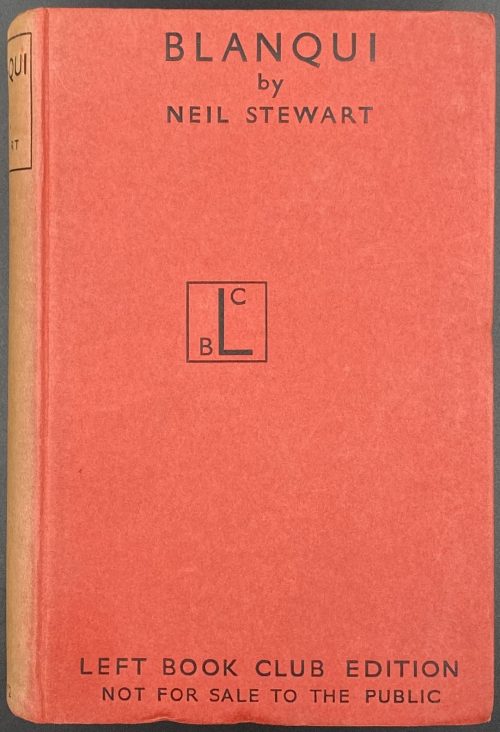 Title: BLANQUI | by | NEIL STEWART | [blank] | LONDON | VICTOR GOLLANCZ LTD | 1939 || Pagination: [1-7] 8-352. Binding: 20 x 13.5 cm; Red cardstock boards with black lettering, the front board: BLANQUI | by | NEIL STEWART | {BCL device} | LEFT BOOK CLUB EDITION | NOT FOR SALE TO THE PUBLIC ||; Spine with black lettering in the frame, sunned.
Title: BLANQUI | by | NEIL STEWART | [blank] | LONDON | VICTOR GOLLANCZ LTD | 1939 || Pagination: [1-7] 8-352. Binding: 20 x 13.5 cm; Red cardstock boards with black lettering, the front board: BLANQUI | by | NEIL STEWART | {BCL device} | LEFT BOOK CLUB EDITION | NOT FOR SALE TO THE PUBLIC ||; Spine with black lettering in the frame, sunned. -
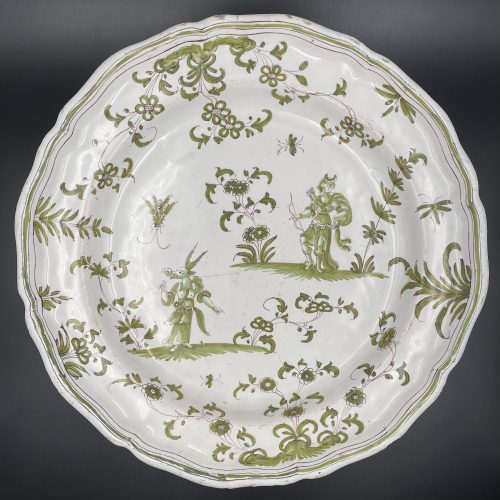 Moustiers faience plate: tin-glazed earthenware plate with a scalloped rim, with green monochrome grotesque decoration of a whimsical creature and a female archer, surrounded by flowering vegetation and insects. Marked "X" on the bottom. "Joseph Fouque/Jean-Francois Pelloquin, started in 1749, used an"X" in its pottery mark". Diameter: 31 cm; Height: 4 cm.
Moustiers faience plate: tin-glazed earthenware plate with a scalloped rim, with green monochrome grotesque decoration of a whimsical creature and a female archer, surrounded by flowering vegetation and insects. Marked "X" on the bottom. "Joseph Fouque/Jean-Francois Pelloquin, started in 1749, used an"X" in its pottery mark". Diameter: 31 cm; Height: 4 cm. -
 Vol. 1 : Title : LES | RUES DE PARIS | PARIS ANCIEN ET MODERNE | ORIGINES, HISTOIRE | MONUMENTS, COSTUMES, MŒURS, CHRONIQUES ET TRADITIONS | OUVRAGE | RÉDIGÉ PAR L’ÉLITE DE LA LITTÉRATURE CONTEMPORAINE | SOUS LA DIRECTION DE | LOUIS LURINE | et illustré de 300 dessins exécutés par les artistes les plus distingués | TOME PREMIER | { publisher’s device «G.K.» in vignette} | PARIS | G. KUGELMANN, ÉDITEUR, 25 RUE JACOB | 1844 || Pagination: [4] [1] 2-396 [4], total number of pages 404, plus 21 wood-engraved plates, incl. frontispiece, extraneous to collation. Collation: 4to; π2 [1]4 2-504, total number of leaves 202, plus 21 leaves of plates. Vol. 2: Title: Same, “TOME SECOND”. Pagination: [4] [1] 2-411 [412] [4], total number of pages 420, plus 22 wood engraved plates, incl. frontispiece, extraneous to collation. Collation: 4to; π2, 1-524, total number of leaves 210, plus 22 leaves of plates. Binding: 27 x 17 cm, two volumes uniformly bound by the publisher in brown cloth, blind-stamped frame and gilt design (corners, coat of arms of Paris, lettering) to boards and spine, yellow endpapers. CONTRIBUTORS: Printer: Alfred Wittersheim (French, 1825 – 1881) Publisher: Georges Kugelmann (French, 1809 – 1882) Editor/Compiler: Louis Lurine (French, 1816 – 1860) Texts by: Briffault, Eugène (French, 1799 – 1854); Janin, Jules Gabriel (French, 1804 – 1874); Huart, Louis Adrien (French, 1813 – 1865); Burette, Théodose (French, 1804 – 1847); Beauvoir, Roger de (French, 1806 – 1866); Brot, Charles Alphonse (French, 1807 – 1895); Le Roux de Lincy, Antoine (French, 1806 – 1869); Achard, Louis Amédée Eugène (French, 1814 – 1875). Illustrated book, profusely illustrated with over 300 woodcuts by: Artists: Daumier, Honoré (French, 1808 – 1879); Gavarni , Paul [Chevalier, Hippolyte Guillaume Sulpice] (French, 1804 – 1866); Nanteuil, Célestin François (French, 1813 – 1873); Baron, Henri (French, 1816 – 1885); Beaumont, Édouard de (French, 1821 – 1888); David, Jules (French, 1808 – 1892); Marckl, Louis (French, b. 1807); Schlesinger, Heinrich [Henri-Guillaume] (German-French, 1814 – 1893); Collignon, François Jules (French, d. 1850); Godefroy, Félix (French, 1765 – 1848); Lemercier, Charles Nicolas (French, 1797 – 1859); Loutrel, Victor Jean-Baptiste (French, 1821 – 1908); May, Edouard (French, c. 1807 – 1881); Moraine, Louis-Pierre René de (French, 1816 – 1864); Moynet, Jean Pierre (French, 1819 – 1876); Rossigneux, Charles (French, 1818 – 1907). Engravers: Bara, J. (French, b. c. 1812); Brugnot (French, fl.c. 1834 – 1873); Castan, André (French, 19th century); Budziłowicz, Ignacy (Polish-French, 1805 – 1863); Chevauchet (French, fl. 1837 – 1850); Pégard (French, 19th century); Czechowicz, A. (Polish-French, fl. 1840 – 1850); Debraine, T. Etienne (French, 19th century); Deschamps, M. (French, 19th century); Fauchery, Jean-Claude Auguste (French, 1798 – 1843); Ghouy, de (French, fl. mid-19th century); Montigneul, Émile (French, fl. 1840 – 1850); Joret, J. (French, 19th century); Fity, A. (French, 19th century); Guillaumot, Eugène (French, 1813 – 1869); Halley-Hiback (French, 19th century); Lacoste père et fils (French, fl. 1830s – 1860s); Lenepveu (French, 19th century); Lesestre, Jean Théophile Gustave (French, 1815 – 1873); Pannemaker, Adolphe François (Belgian-French, 1822 – 1900); Piaud, Antoine Alphée (French, 1813 – 1867); Pisan, Héliodore Joseph (French, 1822 – 1890); Pollet A. (French, 1840 – 1860); Pouget, Jean-Achille (French, fl. 1844 – 1877); Porret, Henri Désiré (French, 1800 – 1867); Pontenier, Auguste [Etienne, François] (French, 1820 – 1888); Rose, Alphonse Antoine (French, fl. 1840 – 1860); Timms, J. (English-French, fl. c. 1839 – 1865); Verdeil, Pierre (French, 1812 – 1874); Vien, Alphonse Jean-Baptiste (French, b. 1814).
Vol. 1 : Title : LES | RUES DE PARIS | PARIS ANCIEN ET MODERNE | ORIGINES, HISTOIRE | MONUMENTS, COSTUMES, MŒURS, CHRONIQUES ET TRADITIONS | OUVRAGE | RÉDIGÉ PAR L’ÉLITE DE LA LITTÉRATURE CONTEMPORAINE | SOUS LA DIRECTION DE | LOUIS LURINE | et illustré de 300 dessins exécutés par les artistes les plus distingués | TOME PREMIER | { publisher’s device «G.K.» in vignette} | PARIS | G. KUGELMANN, ÉDITEUR, 25 RUE JACOB | 1844 || Pagination: [4] [1] 2-396 [4], total number of pages 404, plus 21 wood-engraved plates, incl. frontispiece, extraneous to collation. Collation: 4to; π2 [1]4 2-504, total number of leaves 202, plus 21 leaves of plates. Vol. 2: Title: Same, “TOME SECOND”. Pagination: [4] [1] 2-411 [412] [4], total number of pages 420, plus 22 wood engraved plates, incl. frontispiece, extraneous to collation. Collation: 4to; π2, 1-524, total number of leaves 210, plus 22 leaves of plates. Binding: 27 x 17 cm, two volumes uniformly bound by the publisher in brown cloth, blind-stamped frame and gilt design (corners, coat of arms of Paris, lettering) to boards and spine, yellow endpapers. CONTRIBUTORS: Printer: Alfred Wittersheim (French, 1825 – 1881) Publisher: Georges Kugelmann (French, 1809 – 1882) Editor/Compiler: Louis Lurine (French, 1816 – 1860) Texts by: Briffault, Eugène (French, 1799 – 1854); Janin, Jules Gabriel (French, 1804 – 1874); Huart, Louis Adrien (French, 1813 – 1865); Burette, Théodose (French, 1804 – 1847); Beauvoir, Roger de (French, 1806 – 1866); Brot, Charles Alphonse (French, 1807 – 1895); Le Roux de Lincy, Antoine (French, 1806 – 1869); Achard, Louis Amédée Eugène (French, 1814 – 1875). Illustrated book, profusely illustrated with over 300 woodcuts by: Artists: Daumier, Honoré (French, 1808 – 1879); Gavarni , Paul [Chevalier, Hippolyte Guillaume Sulpice] (French, 1804 – 1866); Nanteuil, Célestin François (French, 1813 – 1873); Baron, Henri (French, 1816 – 1885); Beaumont, Édouard de (French, 1821 – 1888); David, Jules (French, 1808 – 1892); Marckl, Louis (French, b. 1807); Schlesinger, Heinrich [Henri-Guillaume] (German-French, 1814 – 1893); Collignon, François Jules (French, d. 1850); Godefroy, Félix (French, 1765 – 1848); Lemercier, Charles Nicolas (French, 1797 – 1859); Loutrel, Victor Jean-Baptiste (French, 1821 – 1908); May, Edouard (French, c. 1807 – 1881); Moraine, Louis-Pierre René de (French, 1816 – 1864); Moynet, Jean Pierre (French, 1819 – 1876); Rossigneux, Charles (French, 1818 – 1907). Engravers: Bara, J. (French, b. c. 1812); Brugnot (French, fl.c. 1834 – 1873); Castan, André (French, 19th century); Budziłowicz, Ignacy (Polish-French, 1805 – 1863); Chevauchet (French, fl. 1837 – 1850); Pégard (French, 19th century); Czechowicz, A. (Polish-French, fl. 1840 – 1850); Debraine, T. Etienne (French, 19th century); Deschamps, M. (French, 19th century); Fauchery, Jean-Claude Auguste (French, 1798 – 1843); Ghouy, de (French, fl. mid-19th century); Montigneul, Émile (French, fl. 1840 – 1850); Joret, J. (French, 19th century); Fity, A. (French, 19th century); Guillaumot, Eugène (French, 1813 – 1869); Halley-Hiback (French, 19th century); Lacoste père et fils (French, fl. 1830s – 1860s); Lenepveu (French, 19th century); Lesestre, Jean Théophile Gustave (French, 1815 – 1873); Pannemaker, Adolphe François (Belgian-French, 1822 – 1900); Piaud, Antoine Alphée (French, 1813 – 1867); Pisan, Héliodore Joseph (French, 1822 – 1890); Pollet A. (French, 1840 – 1860); Pouget, Jean-Achille (French, fl. 1844 – 1877); Porret, Henri Désiré (French, 1800 – 1867); Pontenier, Auguste [Etienne, François] (French, 1820 – 1888); Rose, Alphonse Antoine (French, fl. 1840 – 1860); Timms, J. (English-French, fl. c. 1839 – 1865); Verdeil, Pierre (French, 1812 – 1874); Vien, Alphonse Jean-Baptiste (French, b. 1814). -
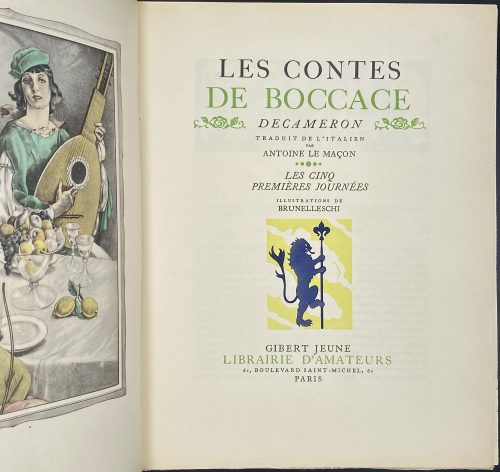 Vol. 1: Front cover and title page: LES CONTES | DE BOCCACE | ☙ DECAMERON ❧ | TRADUIT DE L'ITALIEN | PAR | ANTOINE LE MAÇON | LES CINQ | PREMIÈRES JOURNÉES | ILLUSTRATIONS DE | BRUNELLESCHI | {vignette} | GIBERT JEUNE | LIBRAIRIE D'AMATEURS | 61, BOULEVARD SAINT-MICHEL, 61 | PARIS || Pagination: [6] 1-342 [343-4] [10], 16 colour plates and 70 b/w head- and tailpieces after Umberto Brunelleschi. Vol. 2: Front cover and title page: LES CONTES | DE BOCCACE | ☙ DECAMERON ❧ | TRADUIT DE L'ITALIEN | PAR | ANTOINE LE MAÇON | LES CINQ | DERNIÈRES JOURNÉES | ILLUSTRATIONS DE | BRUNELLESCHI | {vignette} | GIBERT JEUNE | LIBRAIRIE D'AMATEURS | 61, BOULEVARD SAINT-MICHEL, 61 | PARIS || Pagination: [6] 1-281 [282] [10], 16 colour plates and 68 b/w head- and tailpieces after Umberto Brunelleschi. Edition: Limited to 2,500 copies, of which this is № 1. Edition supplemented with two full extra sets of plates, 32 in black and white, and 32 in colour. Printed on June 25, 1934. Binding: 26.5 x 20.5 cm; cream flapped wrappers (French softcover) with green and black lettering and vignettes to front cover and spine, publisher’s device on the back; uncut copy. Paper: Vélin de Navarre (wove paper), size: 260 x 200 mm. Contributors: Giovanni Boccaccio (Italian, 1313 – 1375) – author. Antoine Le Maçon (French, c. 1500 – 1559) – translator. Umberto Brunelleschi (Italian, 1879 – 1949) – artist. Malexis, Louis (French, 20 century) – mise en page. Coulouma, Robert (French, 1887 – 1976), Imprimerie Coulouma (Argenteuil) – printer, H. Barthélemy – director. Dantan, A. – engraver (probably from the family of Edouard Joseph Dantan (French, 1848 – 1897) Charpentier, E. – colour au pochoir. Compare this copy with a small one-volume reprint of 1941: [LIB-2773.2021]. Description of the stensil (au pochoir) technique.
Vol. 1: Front cover and title page: LES CONTES | DE BOCCACE | ☙ DECAMERON ❧ | TRADUIT DE L'ITALIEN | PAR | ANTOINE LE MAÇON | LES CINQ | PREMIÈRES JOURNÉES | ILLUSTRATIONS DE | BRUNELLESCHI | {vignette} | GIBERT JEUNE | LIBRAIRIE D'AMATEURS | 61, BOULEVARD SAINT-MICHEL, 61 | PARIS || Pagination: [6] 1-342 [343-4] [10], 16 colour plates and 70 b/w head- and tailpieces after Umberto Brunelleschi. Vol. 2: Front cover and title page: LES CONTES | DE BOCCACE | ☙ DECAMERON ❧ | TRADUIT DE L'ITALIEN | PAR | ANTOINE LE MAÇON | LES CINQ | DERNIÈRES JOURNÉES | ILLUSTRATIONS DE | BRUNELLESCHI | {vignette} | GIBERT JEUNE | LIBRAIRIE D'AMATEURS | 61, BOULEVARD SAINT-MICHEL, 61 | PARIS || Pagination: [6] 1-281 [282] [10], 16 colour plates and 68 b/w head- and tailpieces after Umberto Brunelleschi. Edition: Limited to 2,500 copies, of which this is № 1. Edition supplemented with two full extra sets of plates, 32 in black and white, and 32 in colour. Printed on June 25, 1934. Binding: 26.5 x 20.5 cm; cream flapped wrappers (French softcover) with green and black lettering and vignettes to front cover and spine, publisher’s device on the back; uncut copy. Paper: Vélin de Navarre (wove paper), size: 260 x 200 mm. Contributors: Giovanni Boccaccio (Italian, 1313 – 1375) – author. Antoine Le Maçon (French, c. 1500 – 1559) – translator. Umberto Brunelleschi (Italian, 1879 – 1949) – artist. Malexis, Louis (French, 20 century) – mise en page. Coulouma, Robert (French, 1887 – 1976), Imprimerie Coulouma (Argenteuil) – printer, H. Barthélemy – director. Dantan, A. – engraver (probably from the family of Edouard Joseph Dantan (French, 1848 – 1897) Charpentier, E. – colour au pochoir. Compare this copy with a small one-volume reprint of 1941: [LIB-2773.2021]. Description of the stensil (au pochoir) technique. -
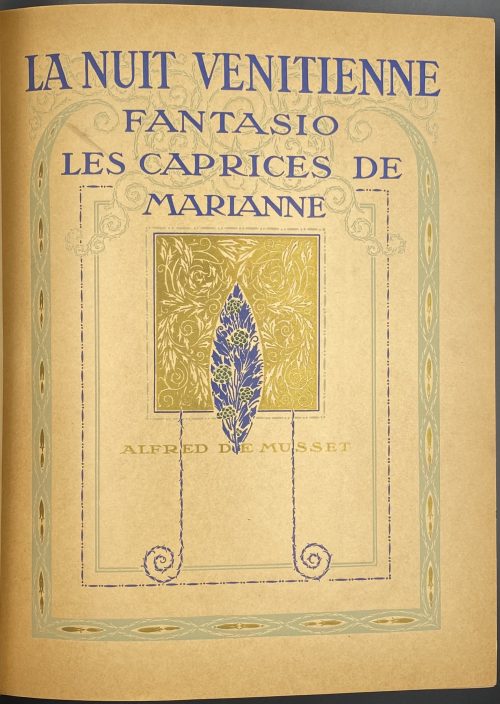 Collation: Prelims (pp.1-6): Blank leaf, front wrapper (ornamental, gilt and colour): LA NUIT VENITIENNE | FANTASIO | LES CAPRICES DE | MARIANNE | ALFRED DE MUSSET ||, blank leaf, [2] – h.t.: LA | NUIT VENITIENNE ||, [2] – t.p. (ornamental frame, marigold and reseda green): ALFRED DE MUSSET | LA NUIT | VENITIENNE | FANTASIA | LES CAPRICES | DE MARIANNE | ILLUSTRATIONS | DE | U. BRUNELLESCHI | L’EDITION D’ART H.PIAZZA | PARIS ||, [2] – ornamental divisional title: LA NUIT VENITIENNE ||, 7-138 [139/40] – contents / list of ills., [141-2] – limitation / colophon, blank leaf, back wrapper, blank leaf; plus 20 stencil-coloured (au pochoir) plates after gouaches by Umberto Brunelleschi, incl. frontispiece with red-lettered tissue guards; two more divisional titles, three headpieces in black; text printed on heavy wove paper, in an ornamental frame. Edition: 1st; limited to 500 copies on laid paper (papier du Japon) signed by the artist; this copy on wove paper without signatures, without limitation. Printed in Paris on the 10th of November 1913. Binding: 30 x 24 cm, owner’s green bead-grain buckram with a gilt-lettered black label to spine LA NUIT | VENITIENNE, publisher’s wrappers bound in, green and gilt endpapers. Alfred de Musset (French, 1810 – 1857) – author. Umberto Brunelleschi (Italian, 1879 – 1949) – artist. L’Edition d’art H. Piazza; Henri Jules Piazza (Italian, 1861 – 1929) – publisher, printer.
Collation: Prelims (pp.1-6): Blank leaf, front wrapper (ornamental, gilt and colour): LA NUIT VENITIENNE | FANTASIO | LES CAPRICES DE | MARIANNE | ALFRED DE MUSSET ||, blank leaf, [2] – h.t.: LA | NUIT VENITIENNE ||, [2] – t.p. (ornamental frame, marigold and reseda green): ALFRED DE MUSSET | LA NUIT | VENITIENNE | FANTASIA | LES CAPRICES | DE MARIANNE | ILLUSTRATIONS | DE | U. BRUNELLESCHI | L’EDITION D’ART H.PIAZZA | PARIS ||, [2] – ornamental divisional title: LA NUIT VENITIENNE ||, 7-138 [139/40] – contents / list of ills., [141-2] – limitation / colophon, blank leaf, back wrapper, blank leaf; plus 20 stencil-coloured (au pochoir) plates after gouaches by Umberto Brunelleschi, incl. frontispiece with red-lettered tissue guards; two more divisional titles, three headpieces in black; text printed on heavy wove paper, in an ornamental frame. Edition: 1st; limited to 500 copies on laid paper (papier du Japon) signed by the artist; this copy on wove paper without signatures, without limitation. Printed in Paris on the 10th of November 1913. Binding: 30 x 24 cm, owner’s green bead-grain buckram with a gilt-lettered black label to spine LA NUIT | VENITIENNE, publisher’s wrappers bound in, green and gilt endpapers. Alfred de Musset (French, 1810 – 1857) – author. Umberto Brunelleschi (Italian, 1879 – 1949) – artist. L’Edition d’art H. Piazza; Henri Jules Piazza (Italian, 1861 – 1929) – publisher, printer.


